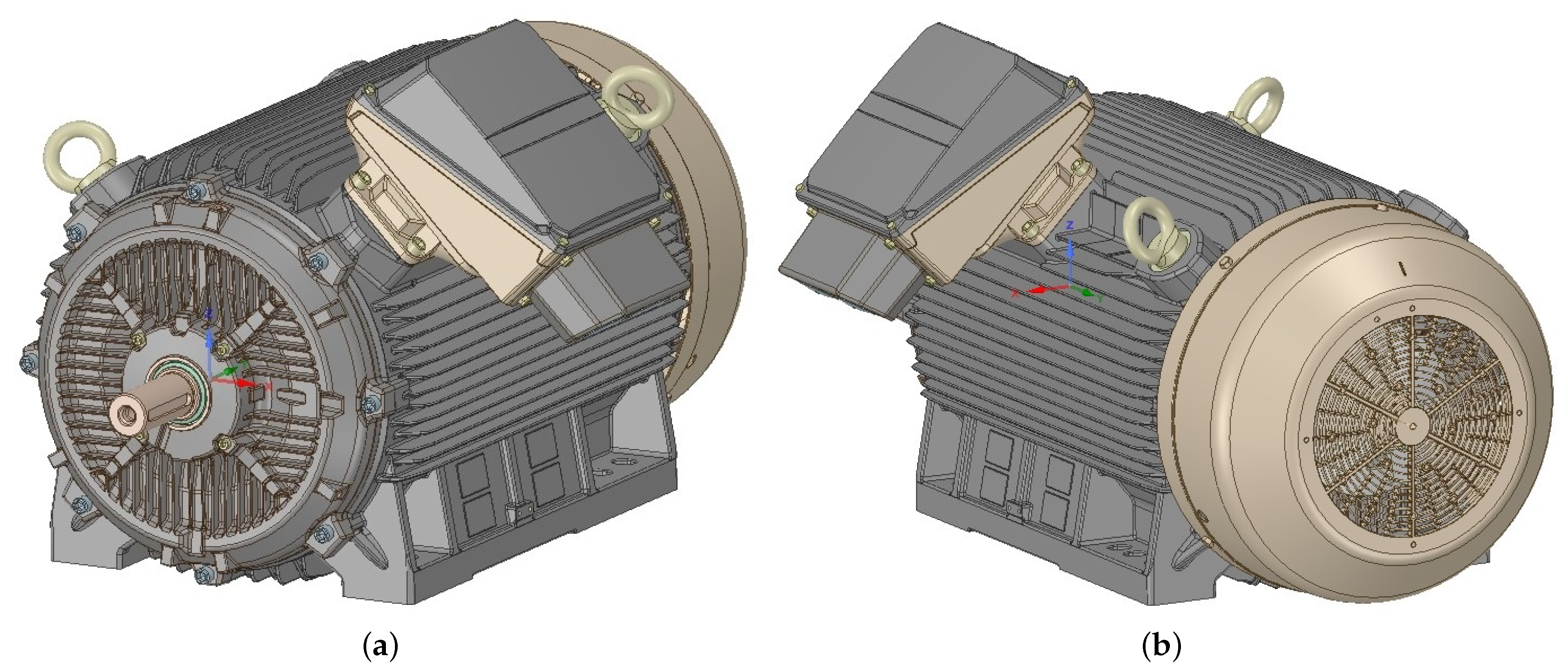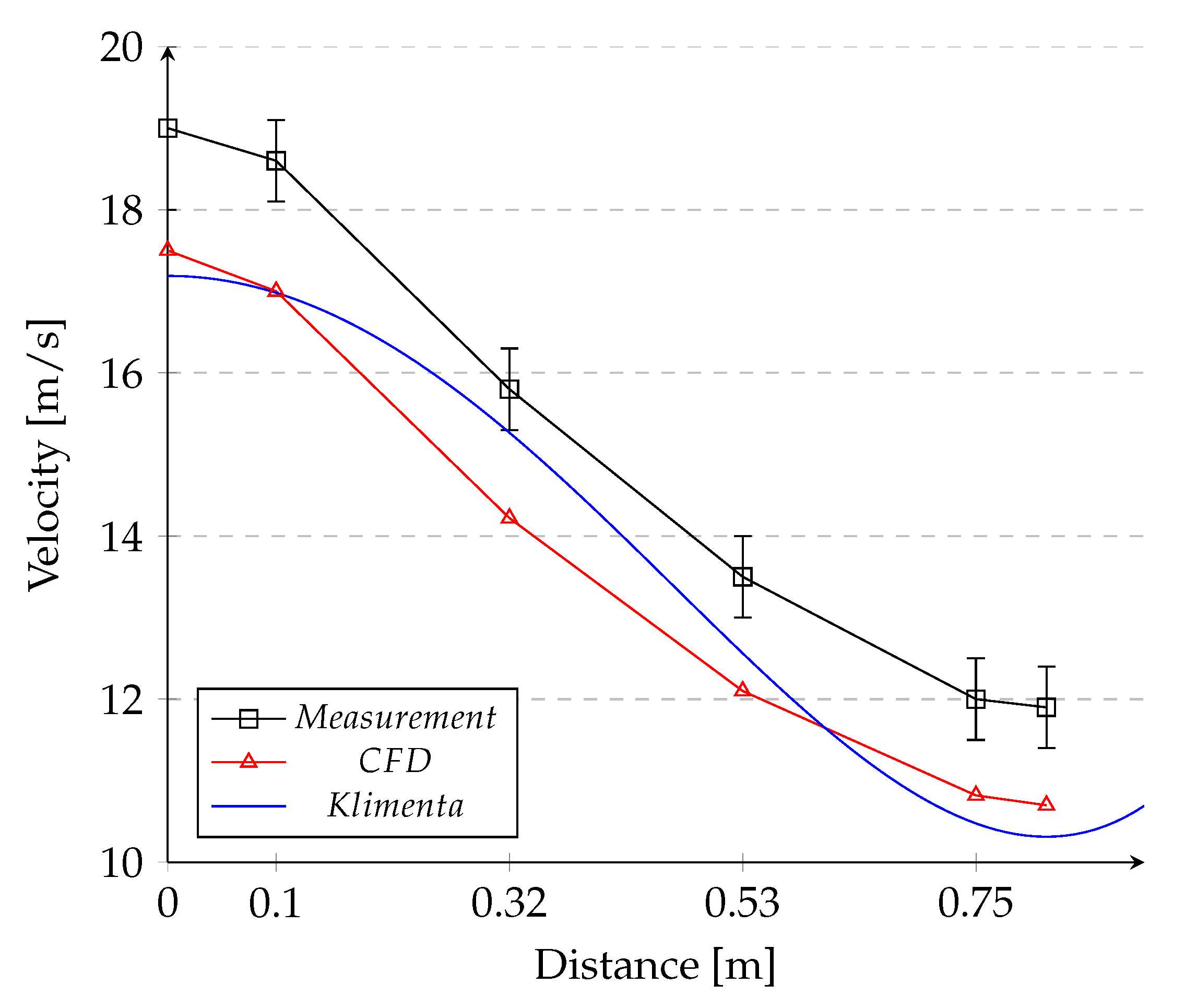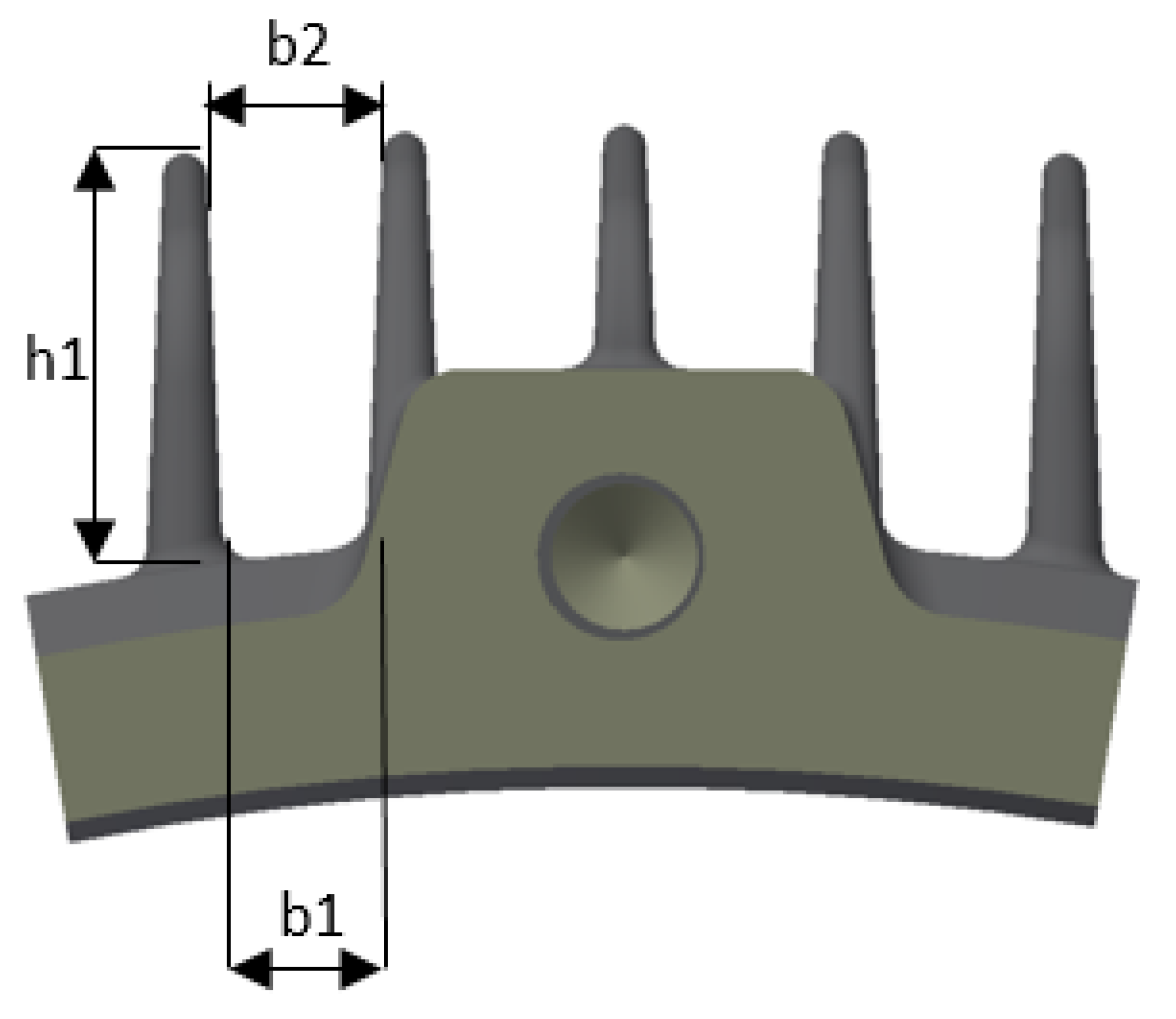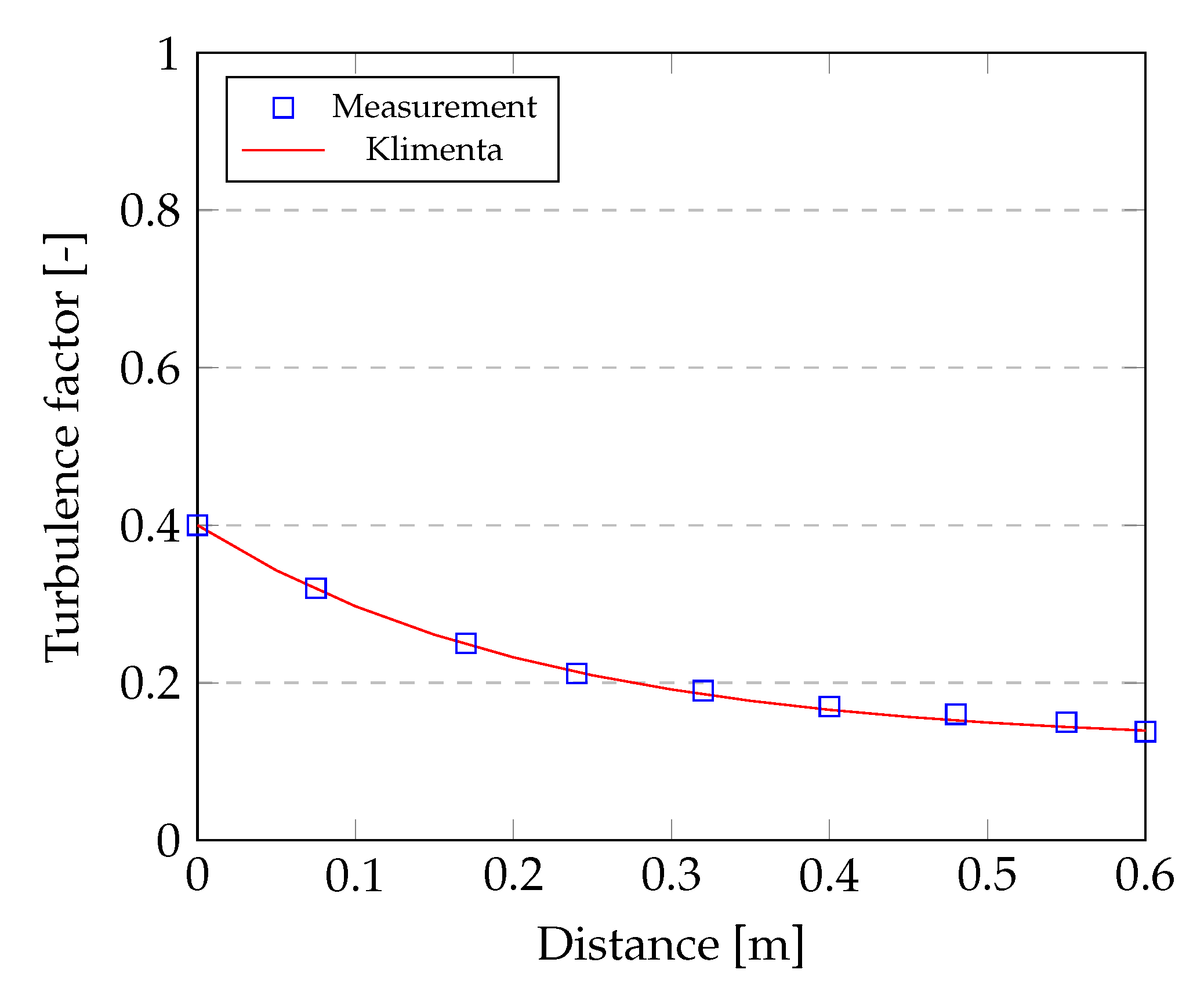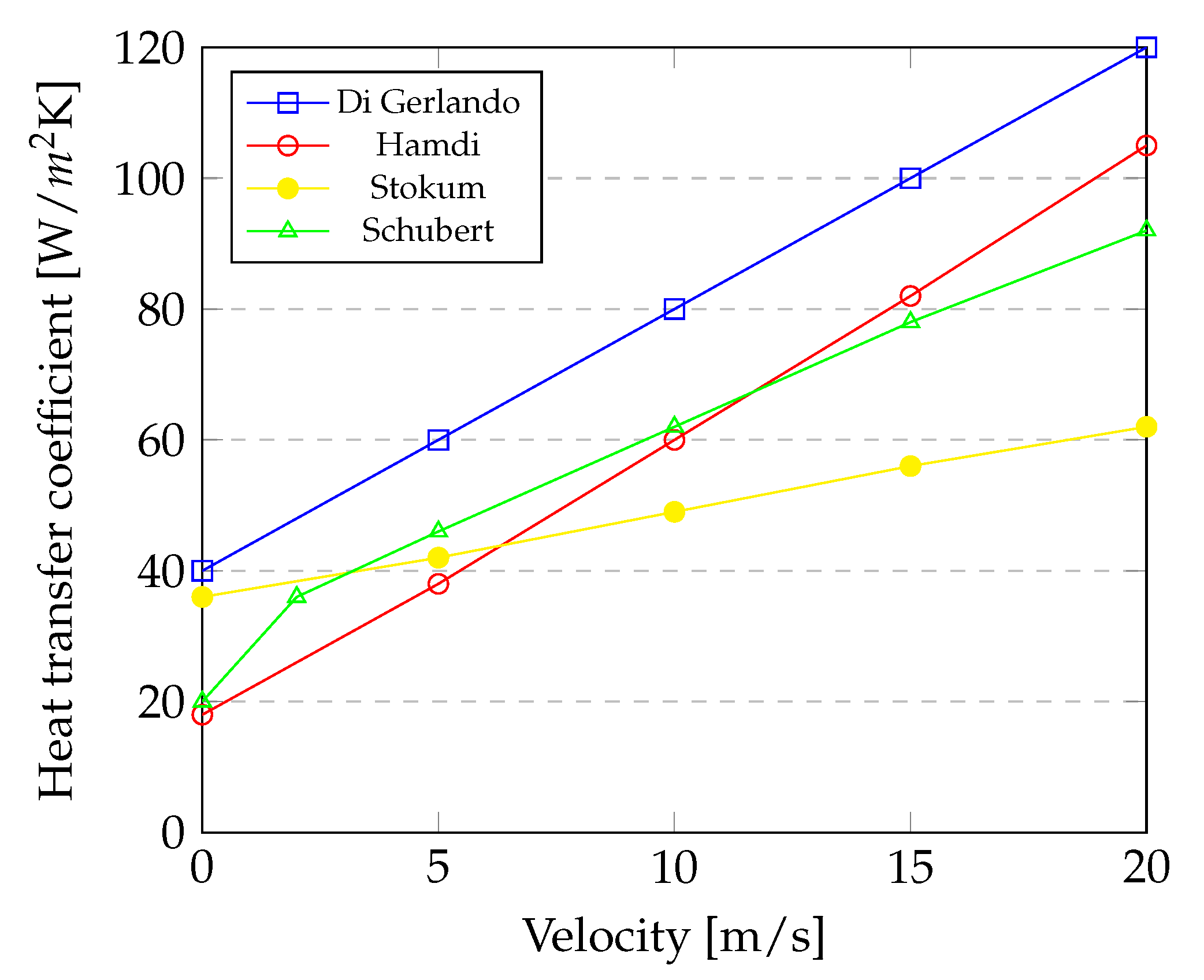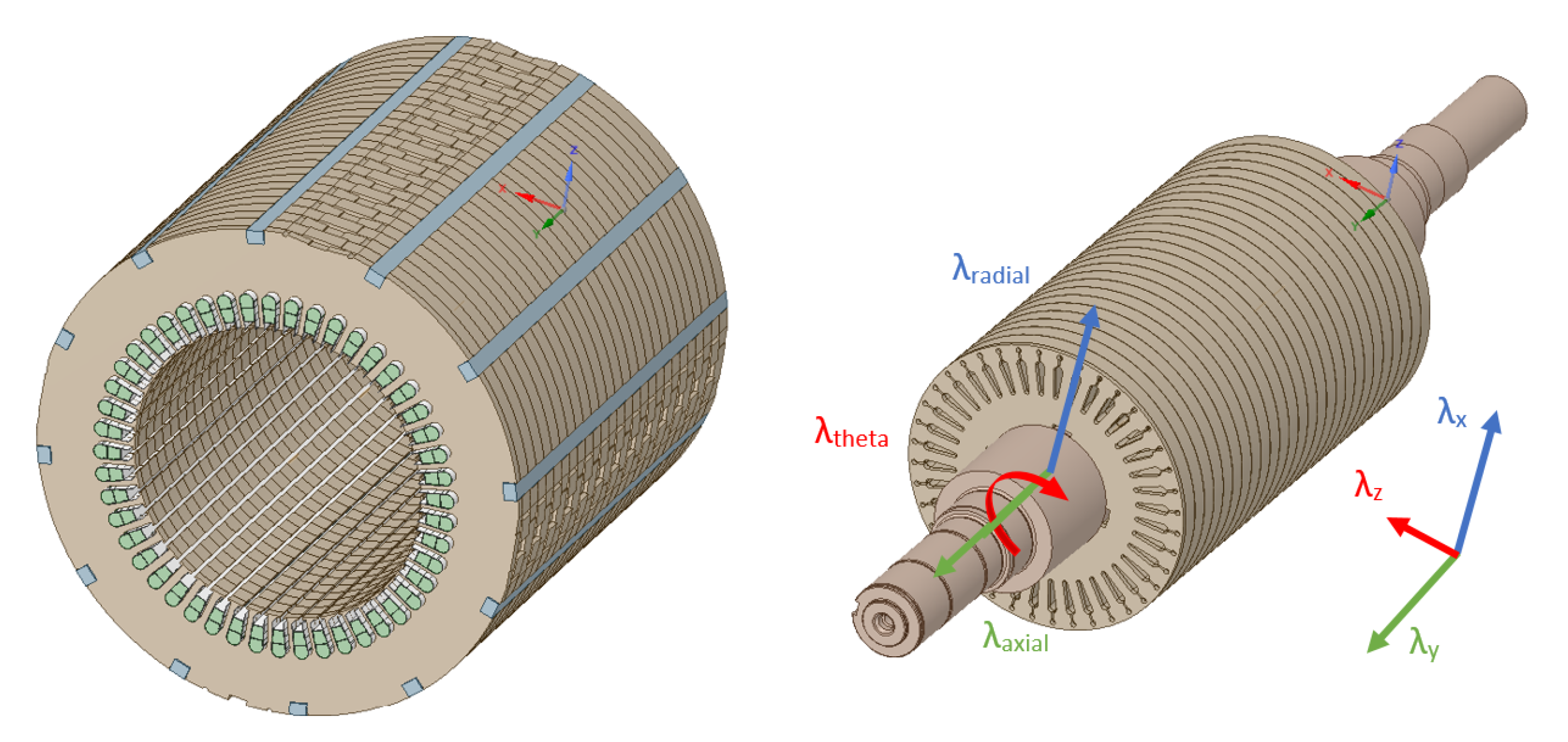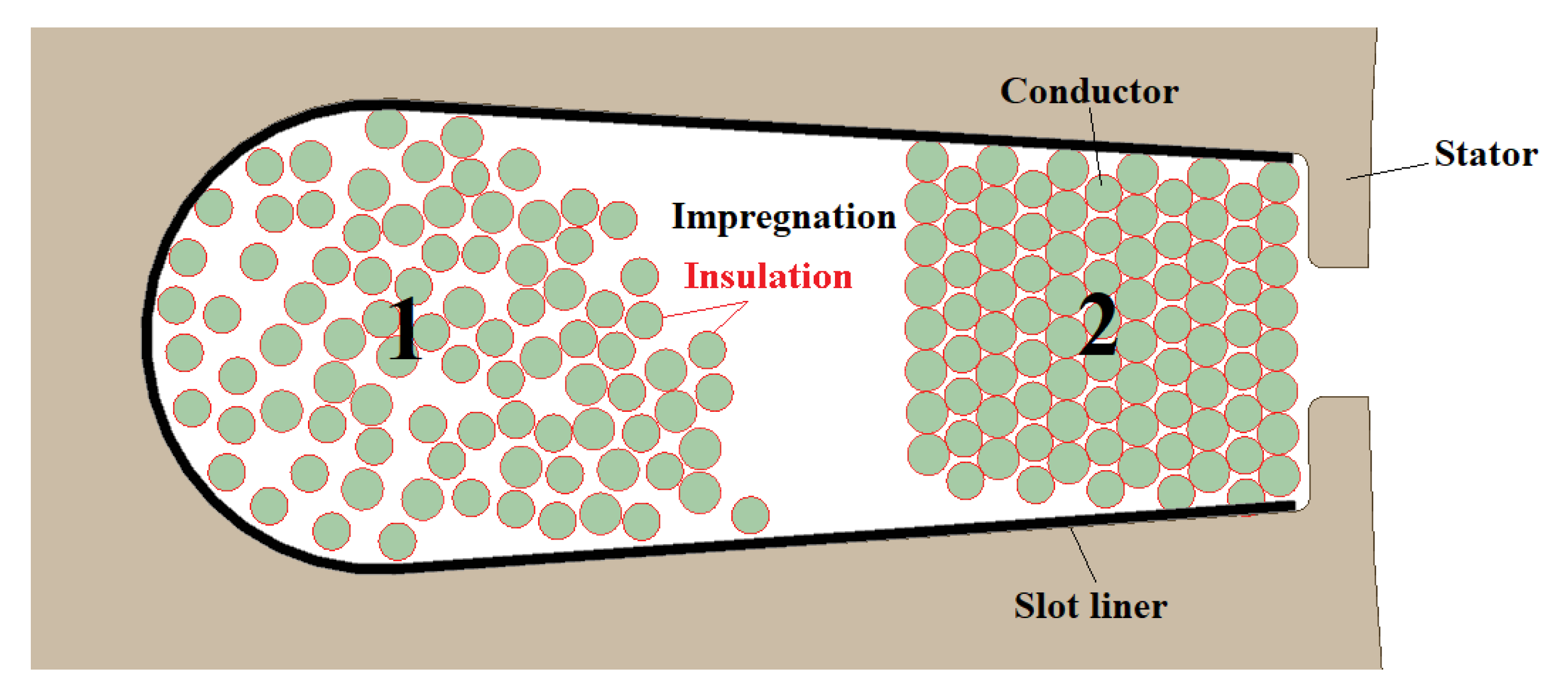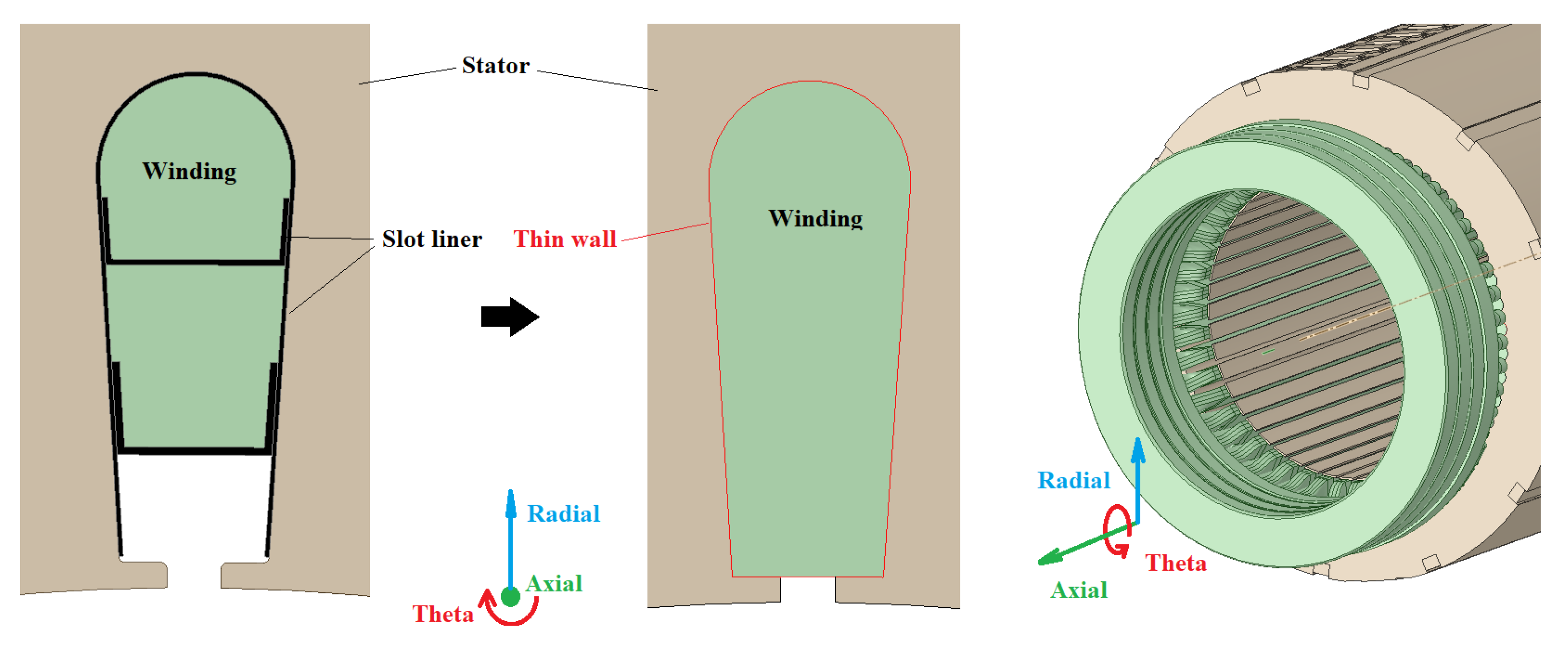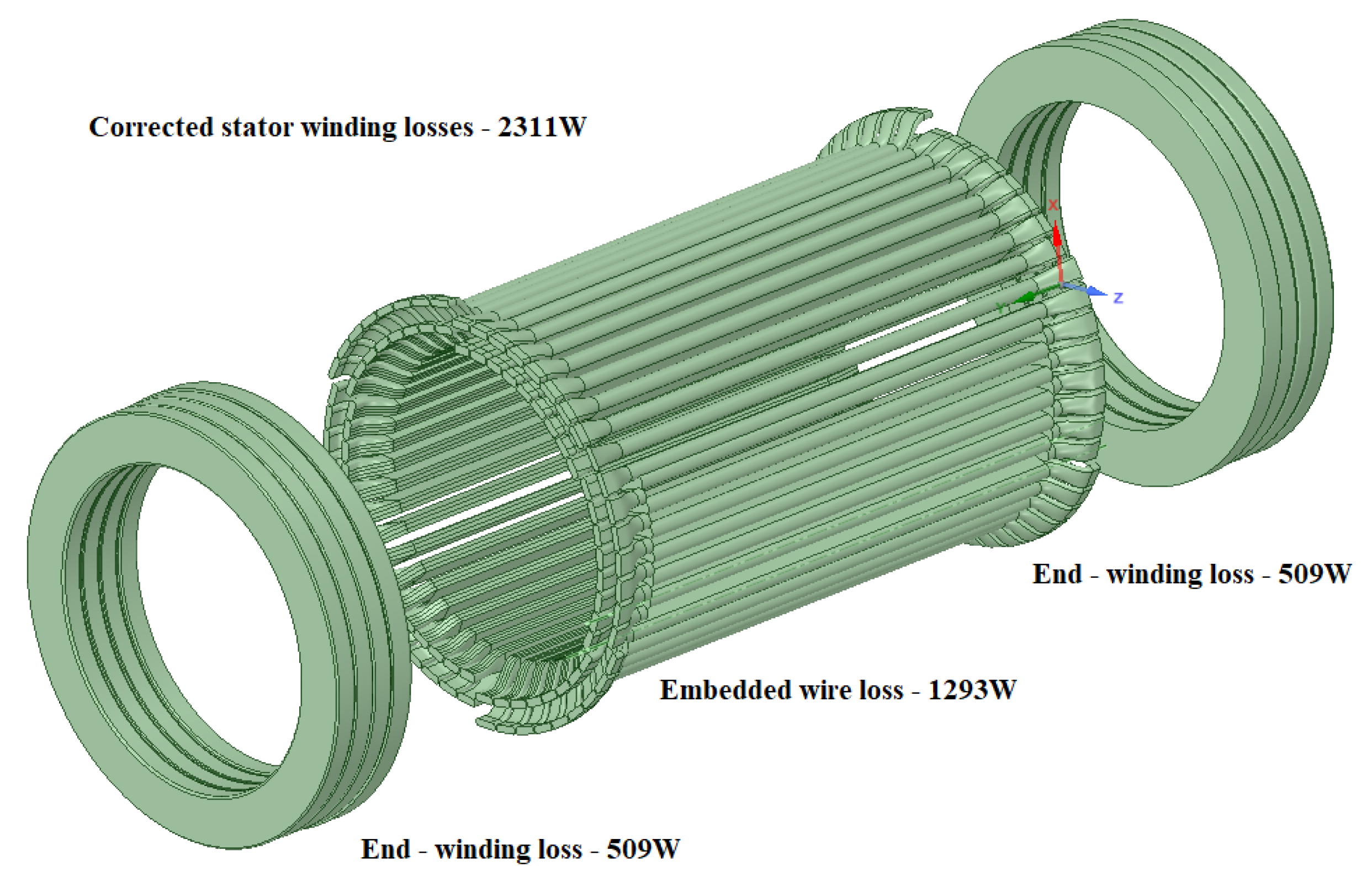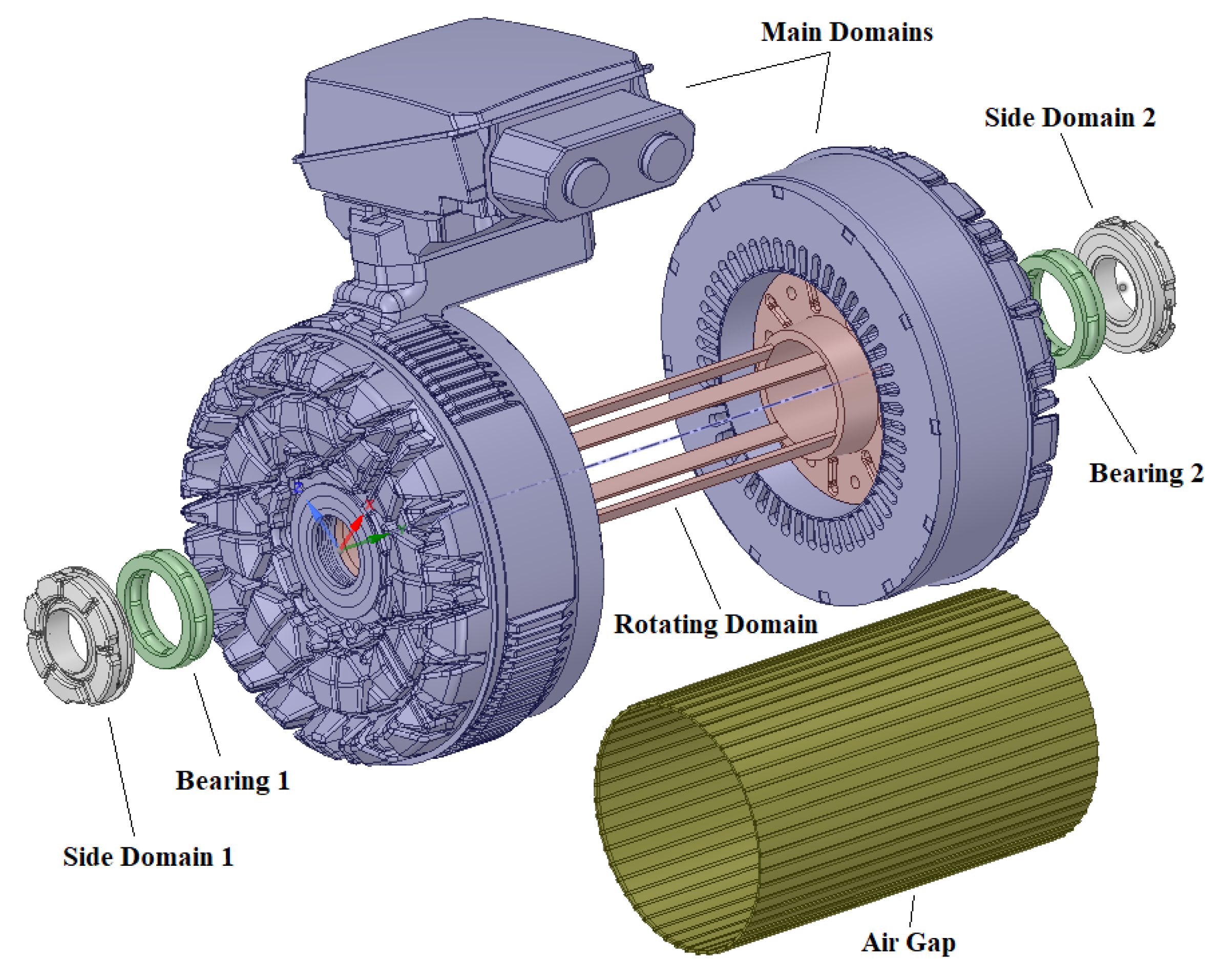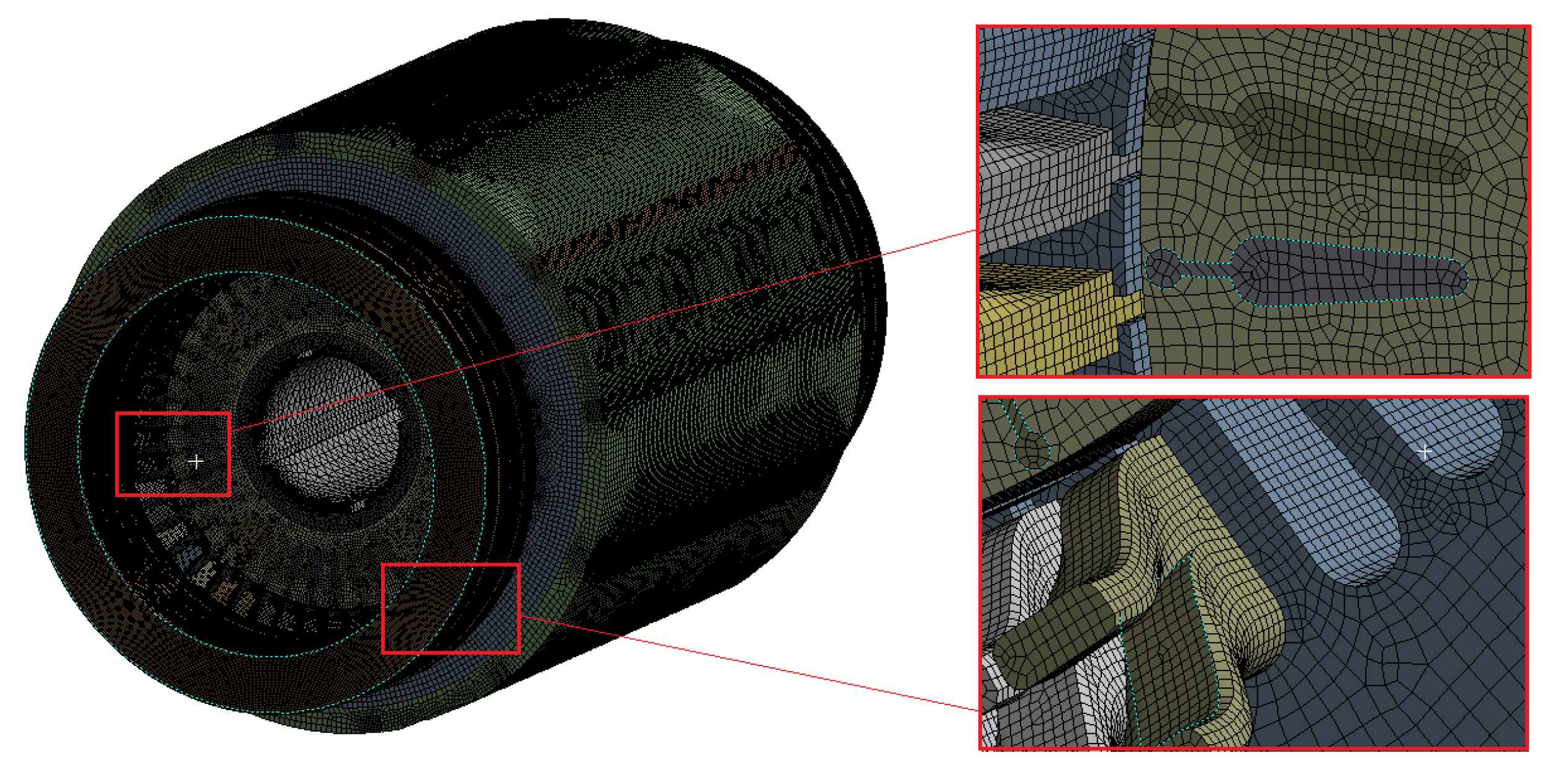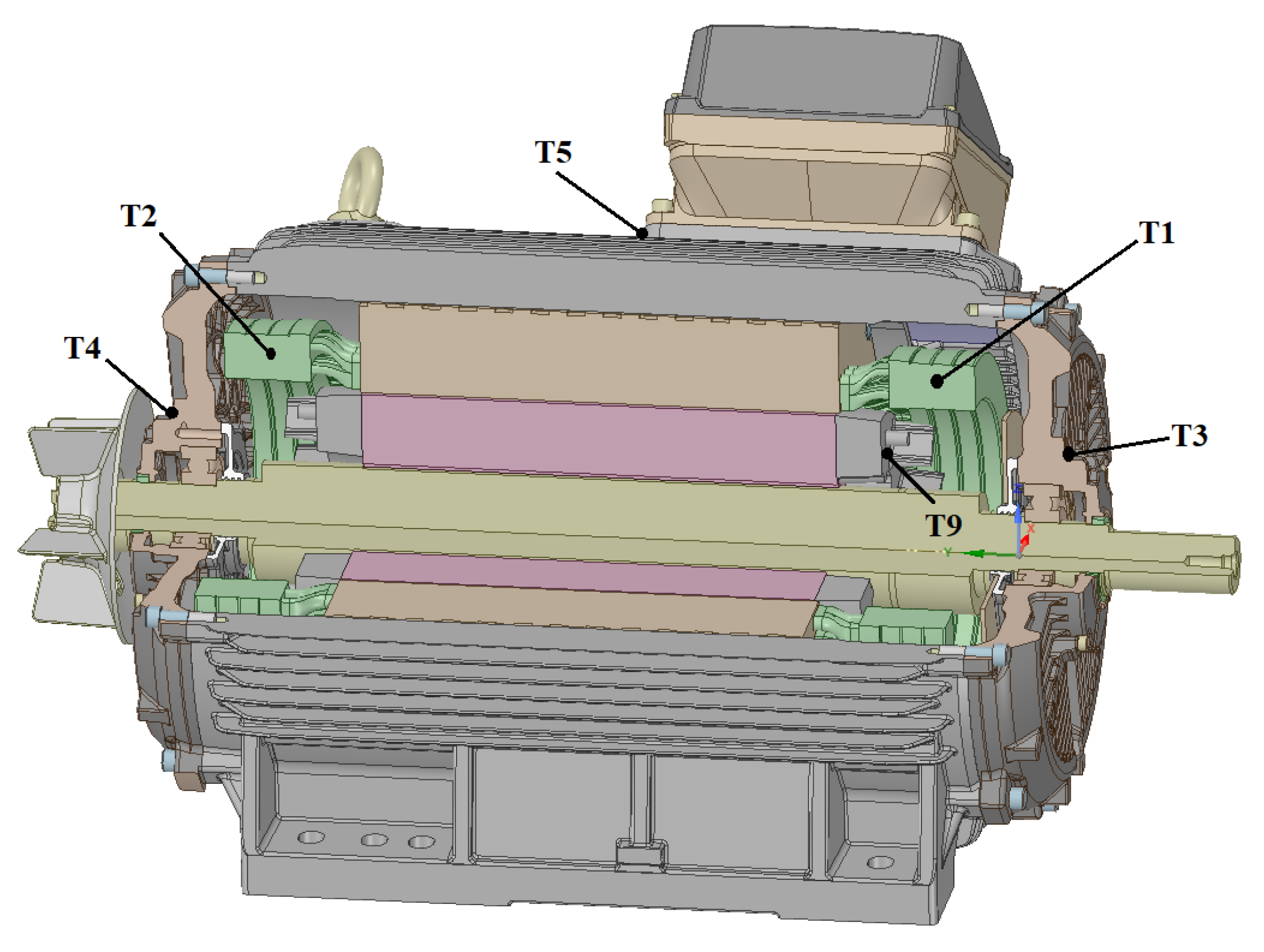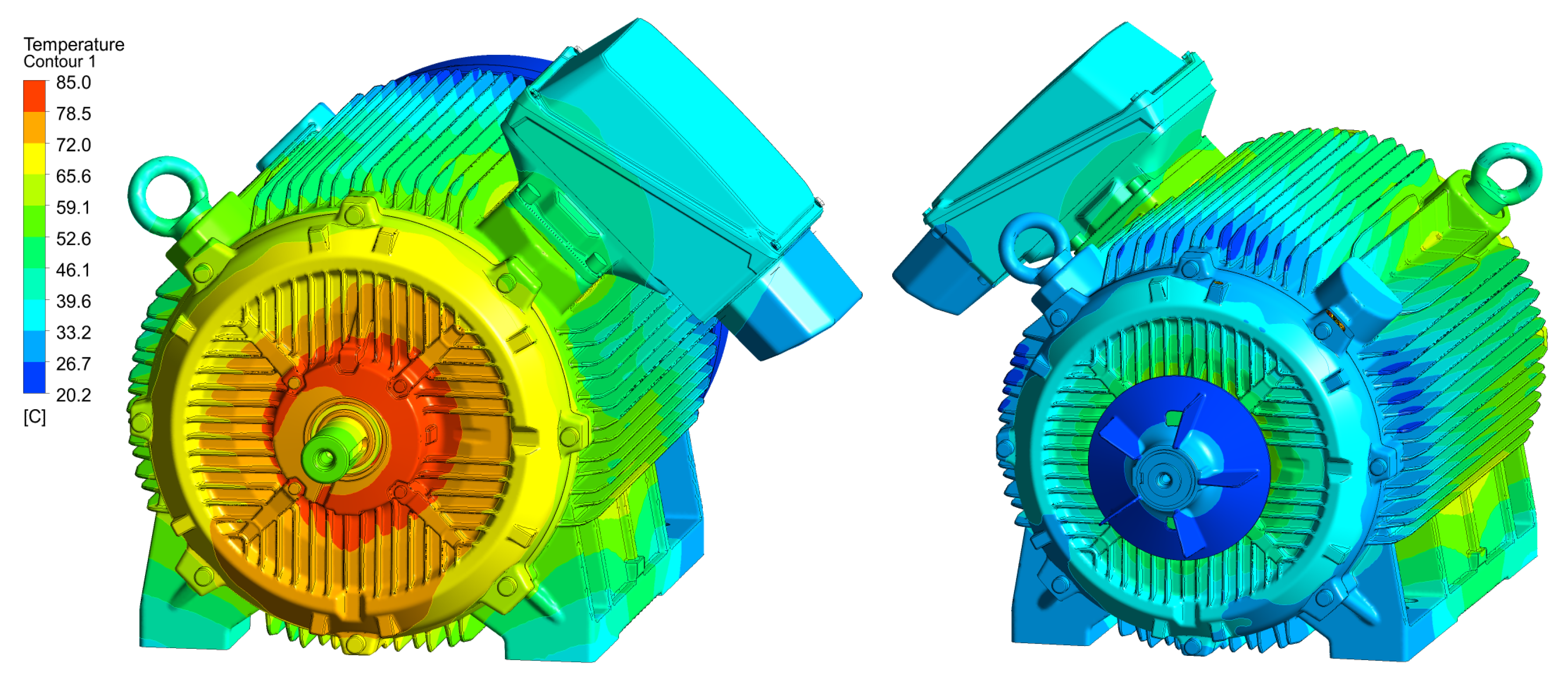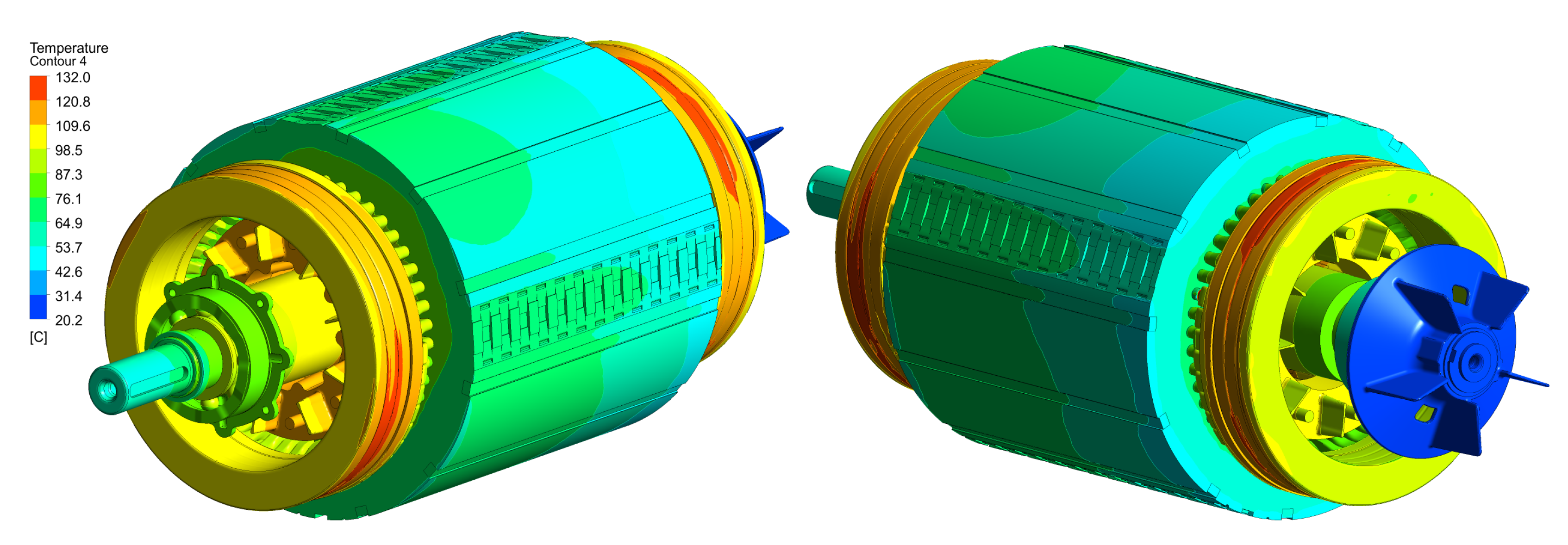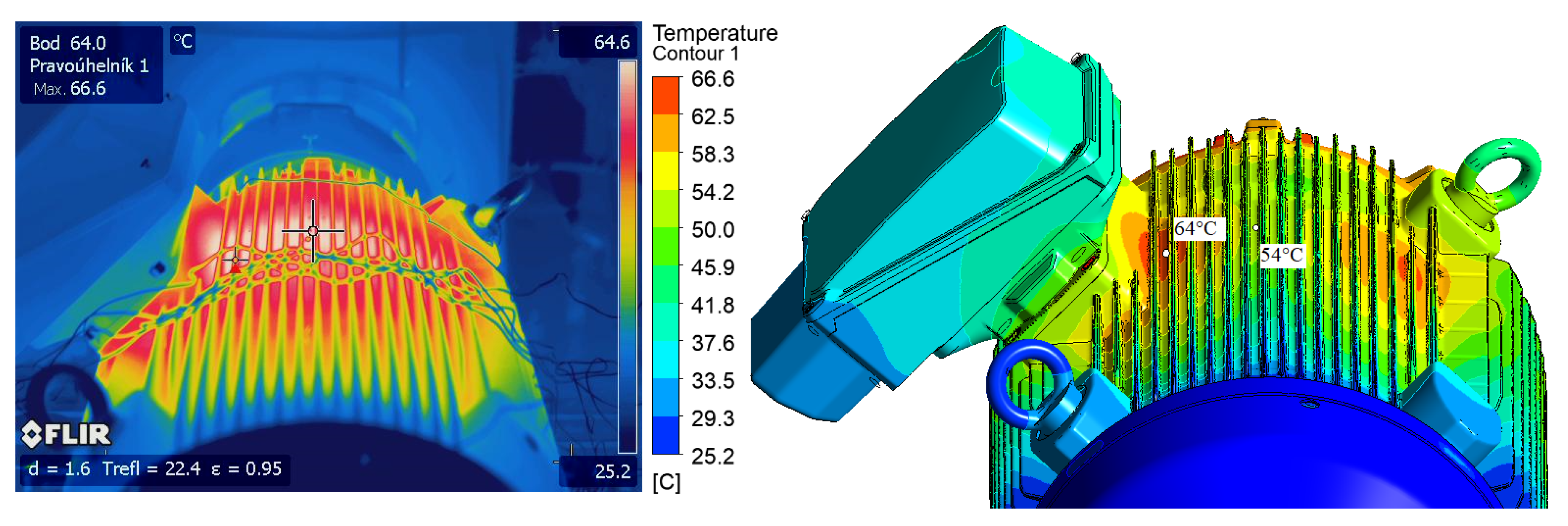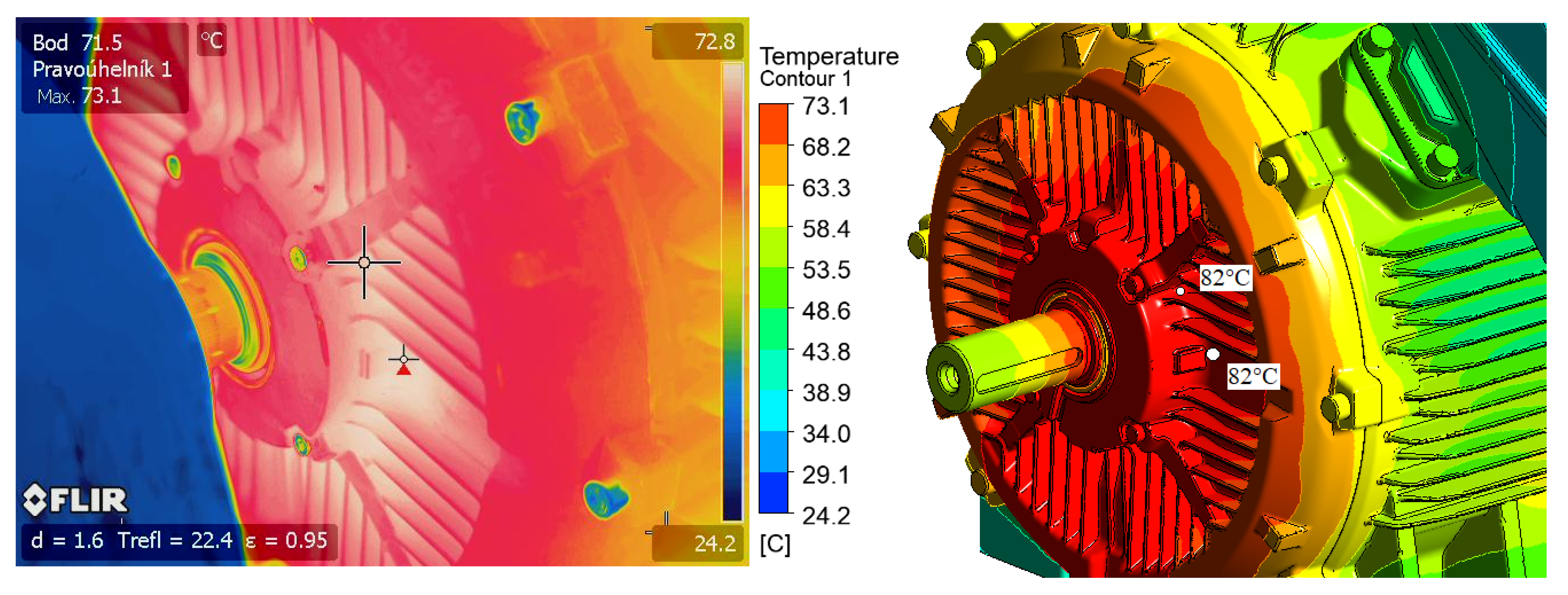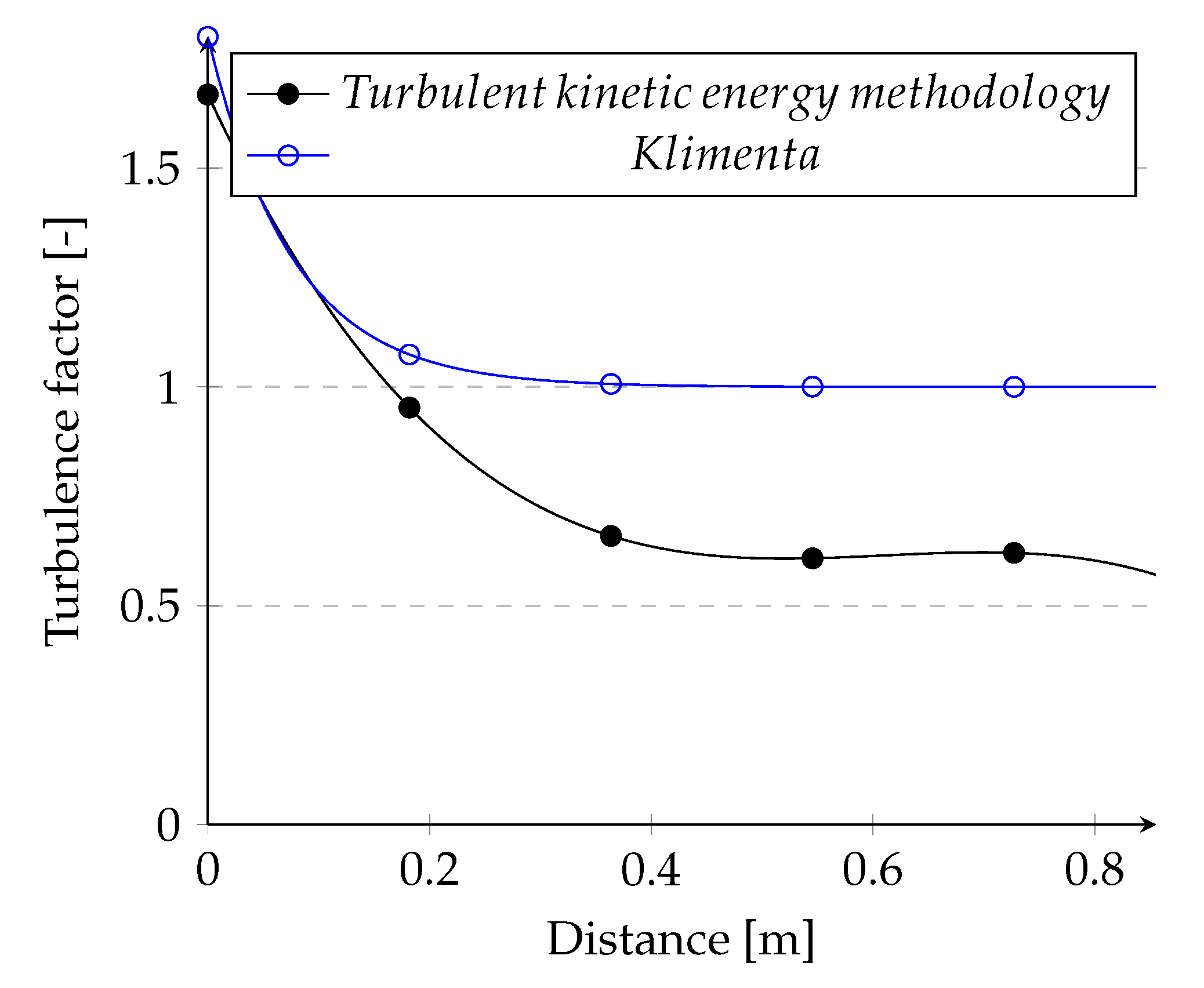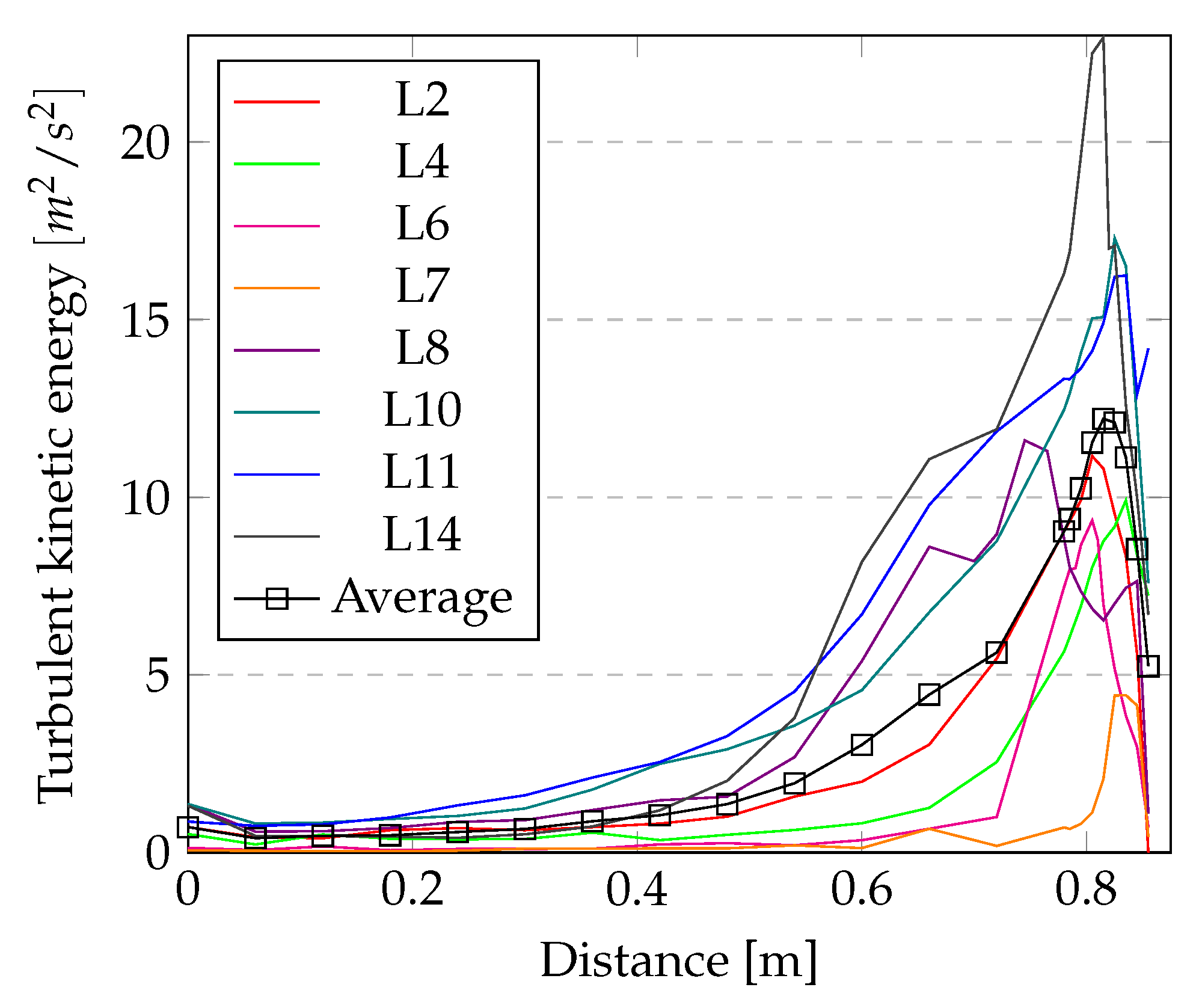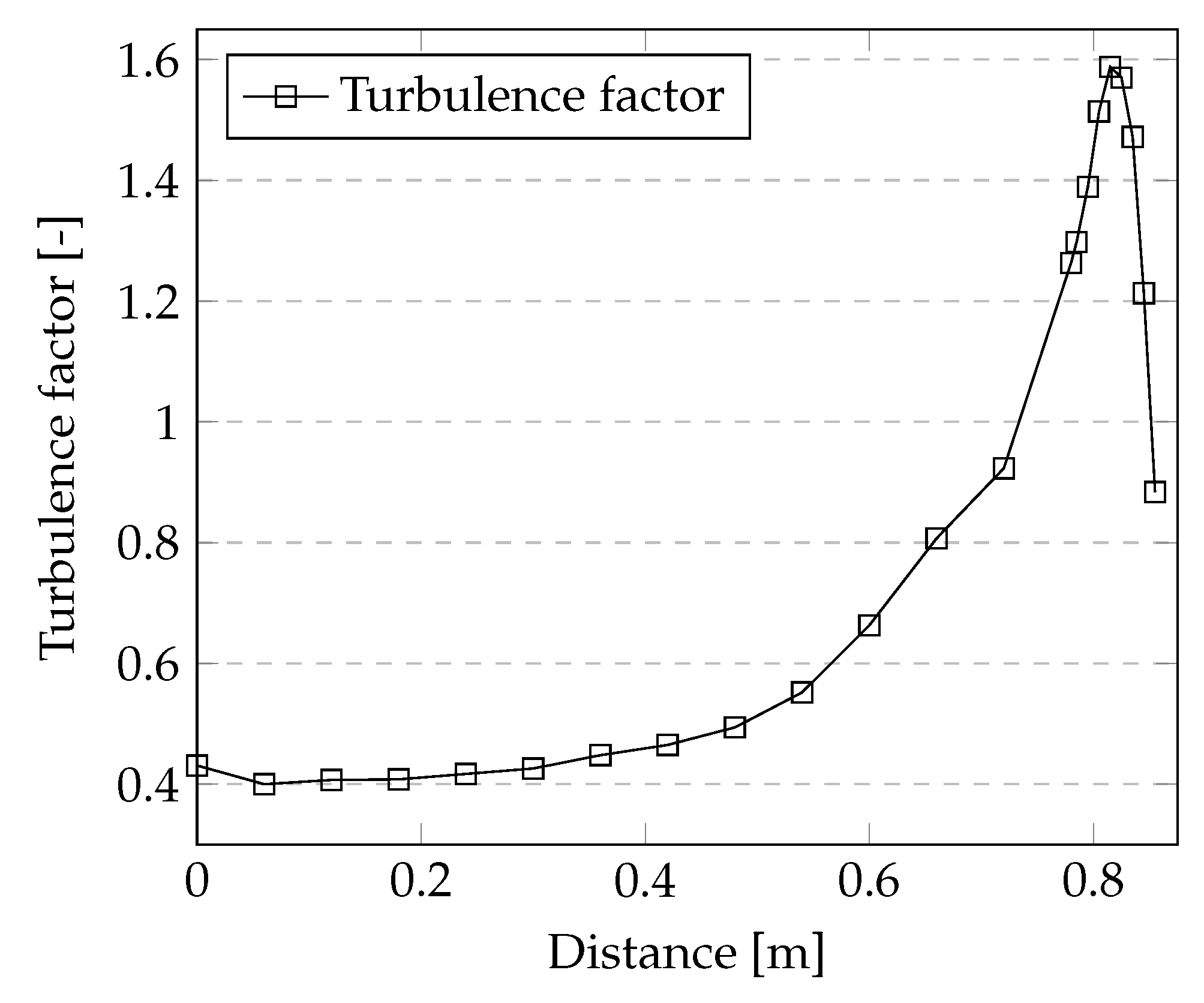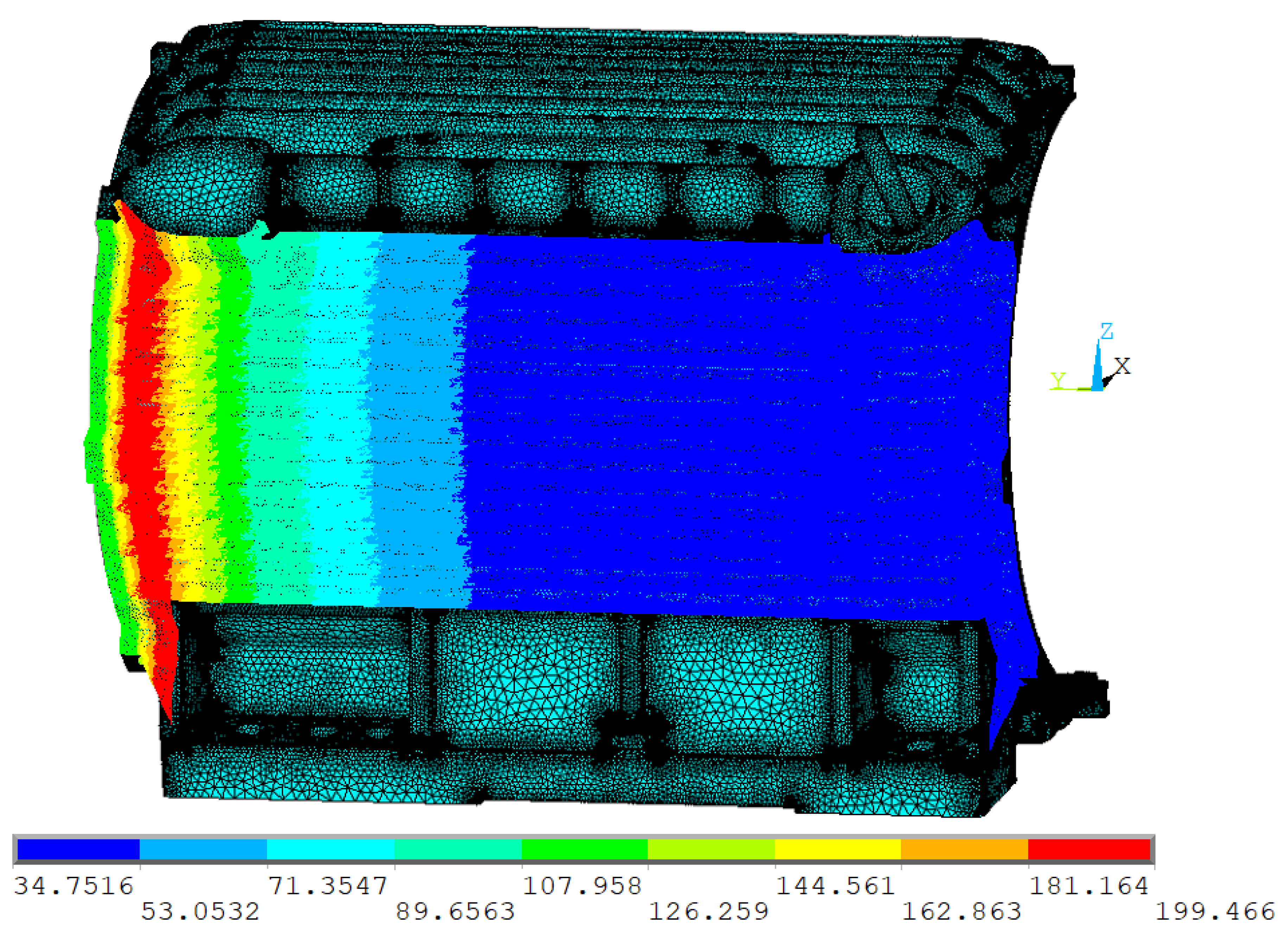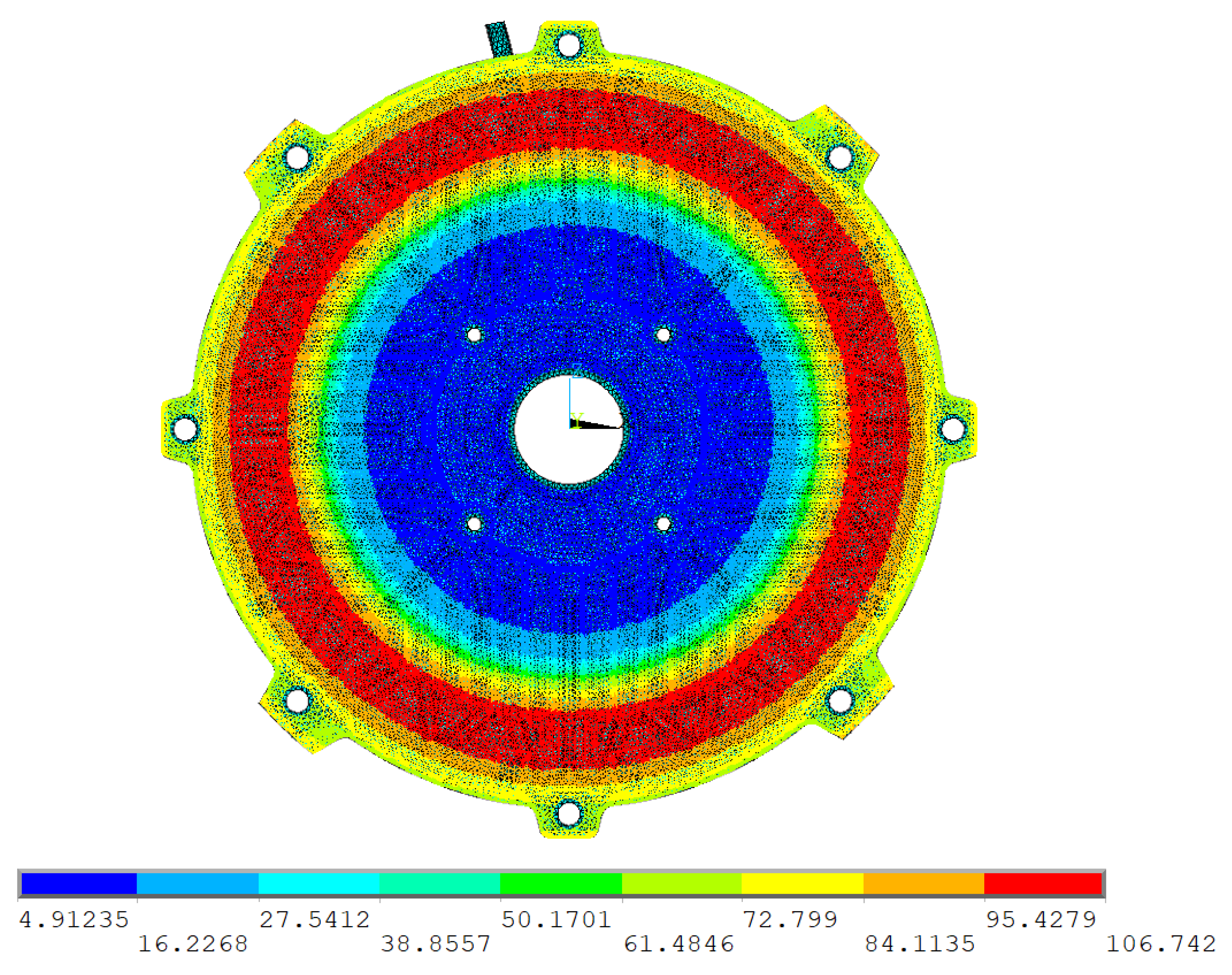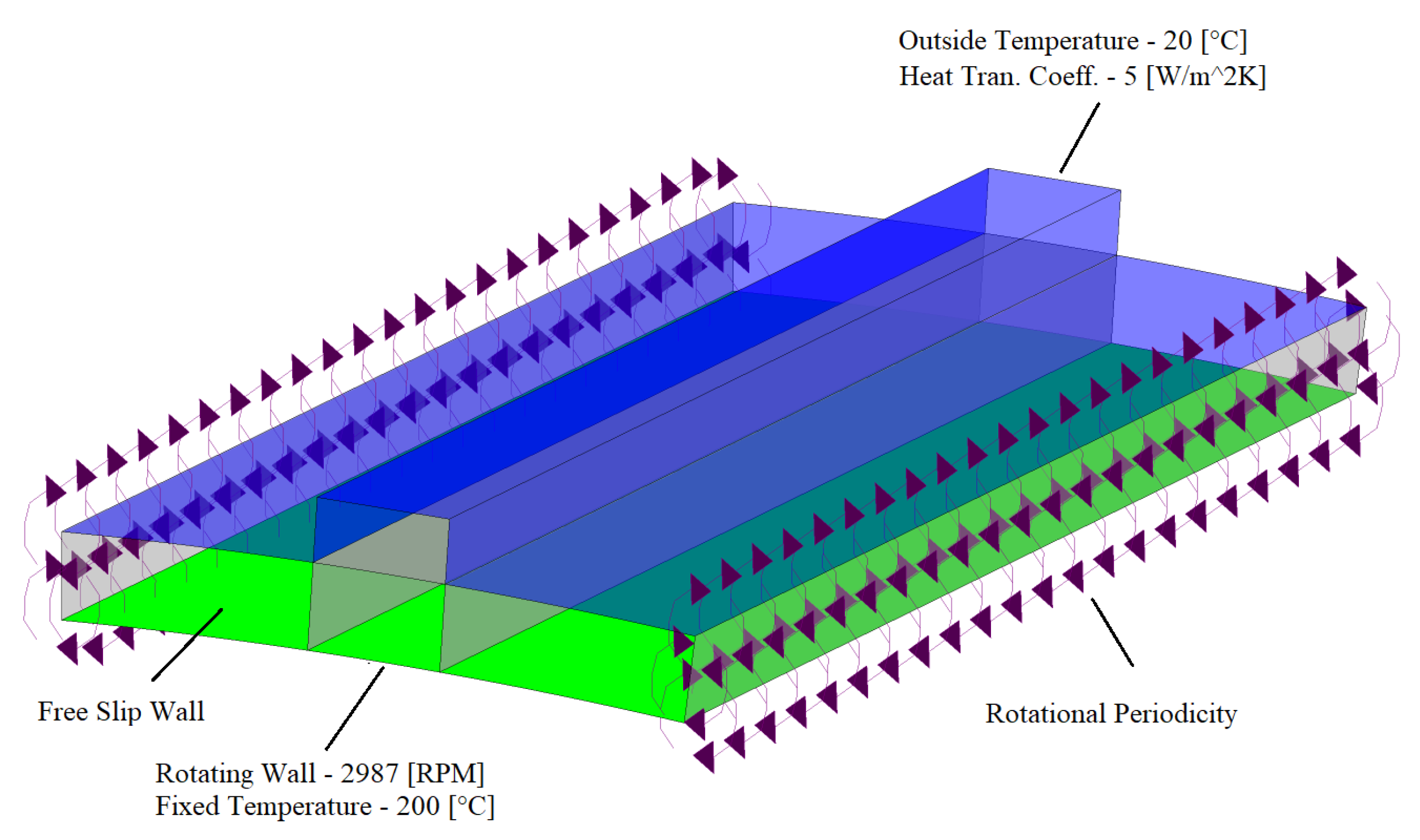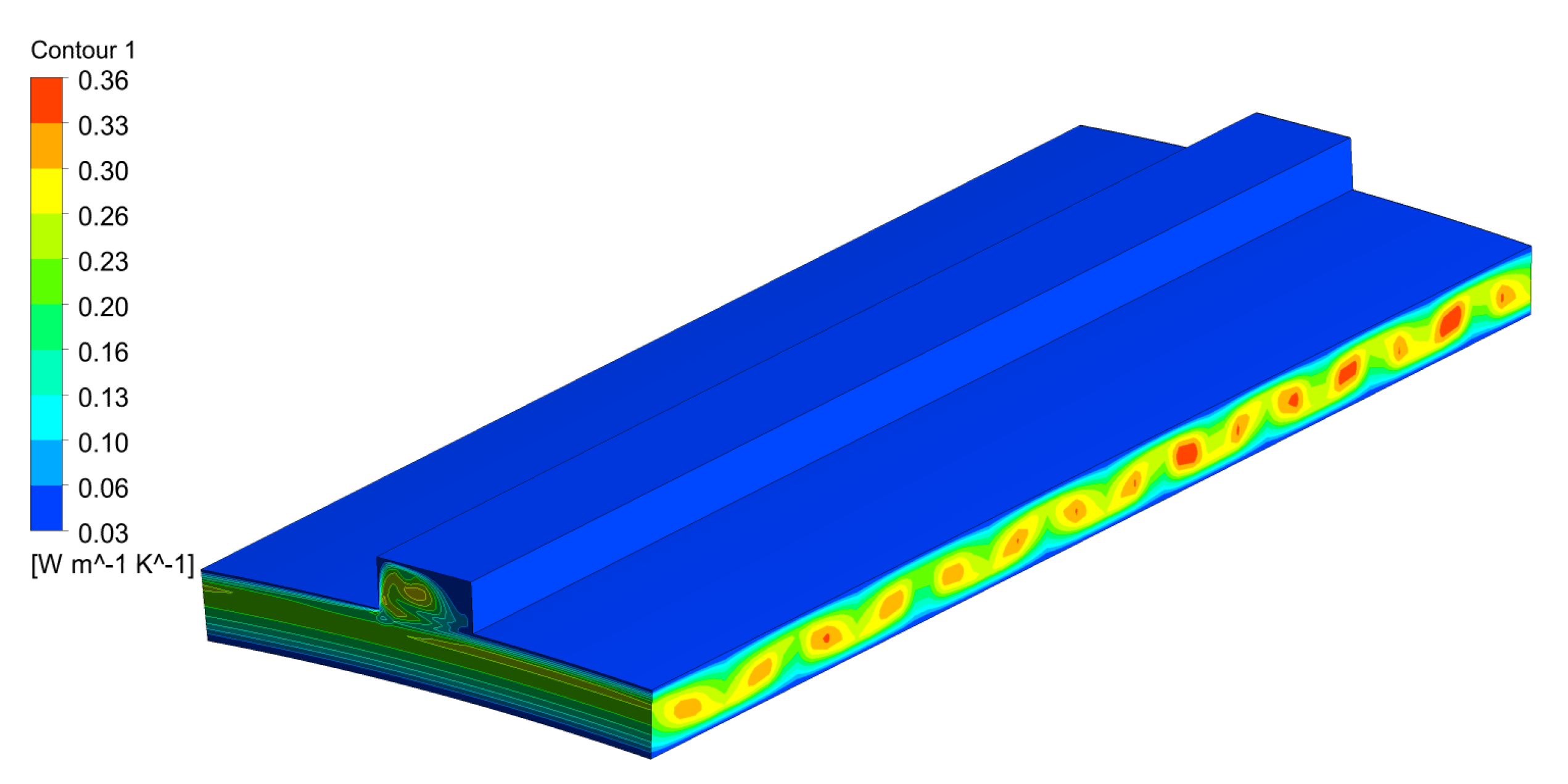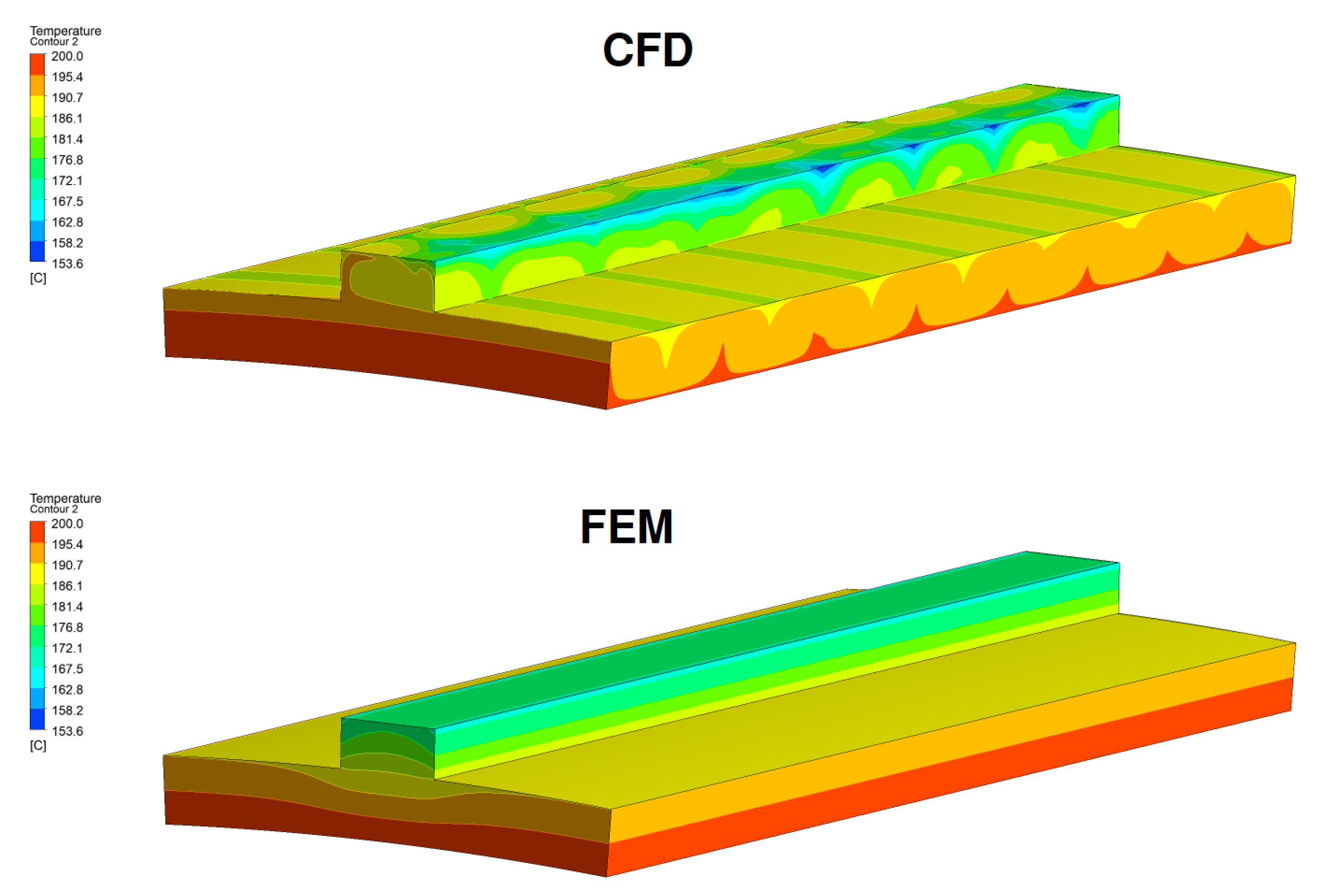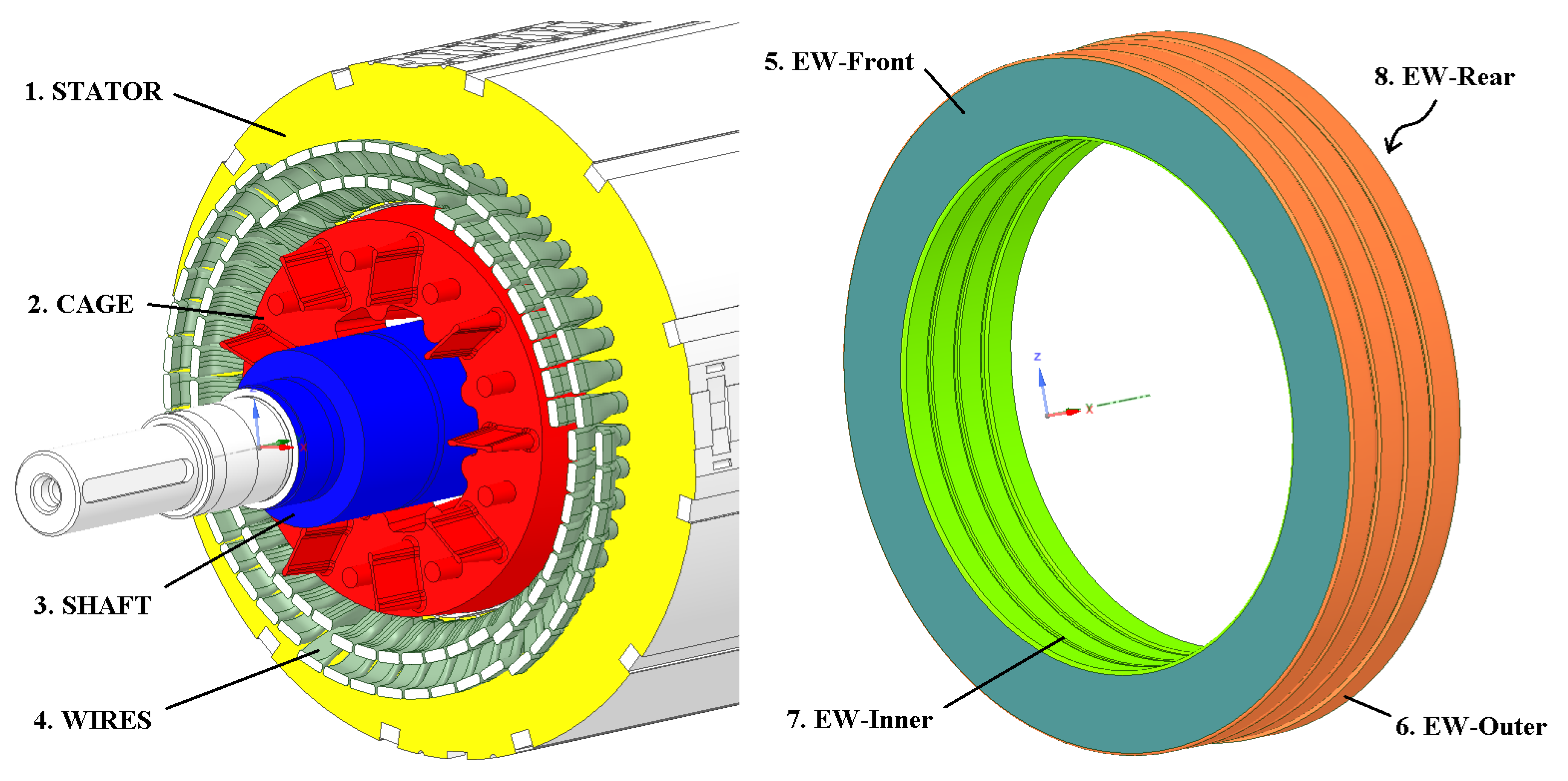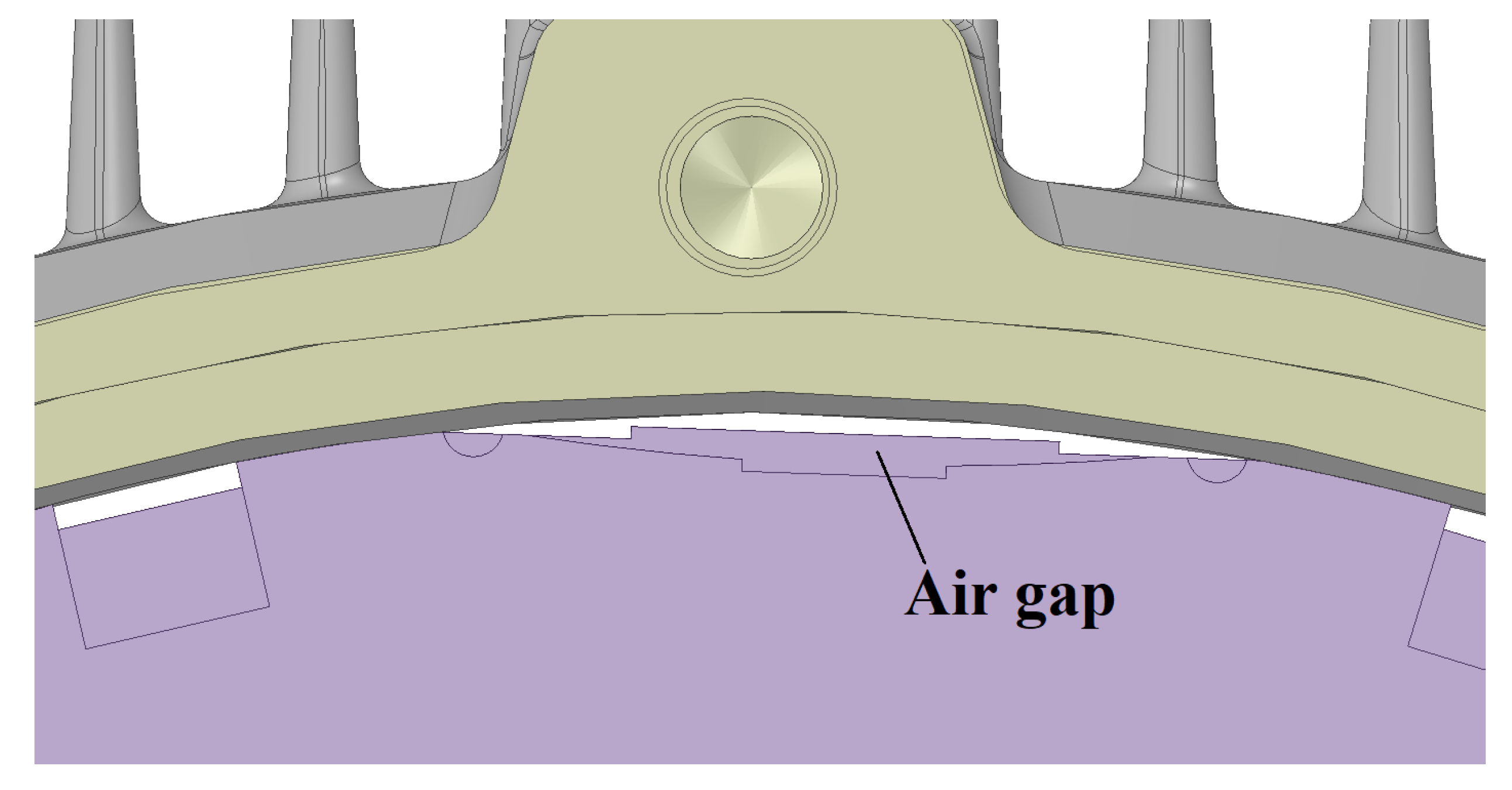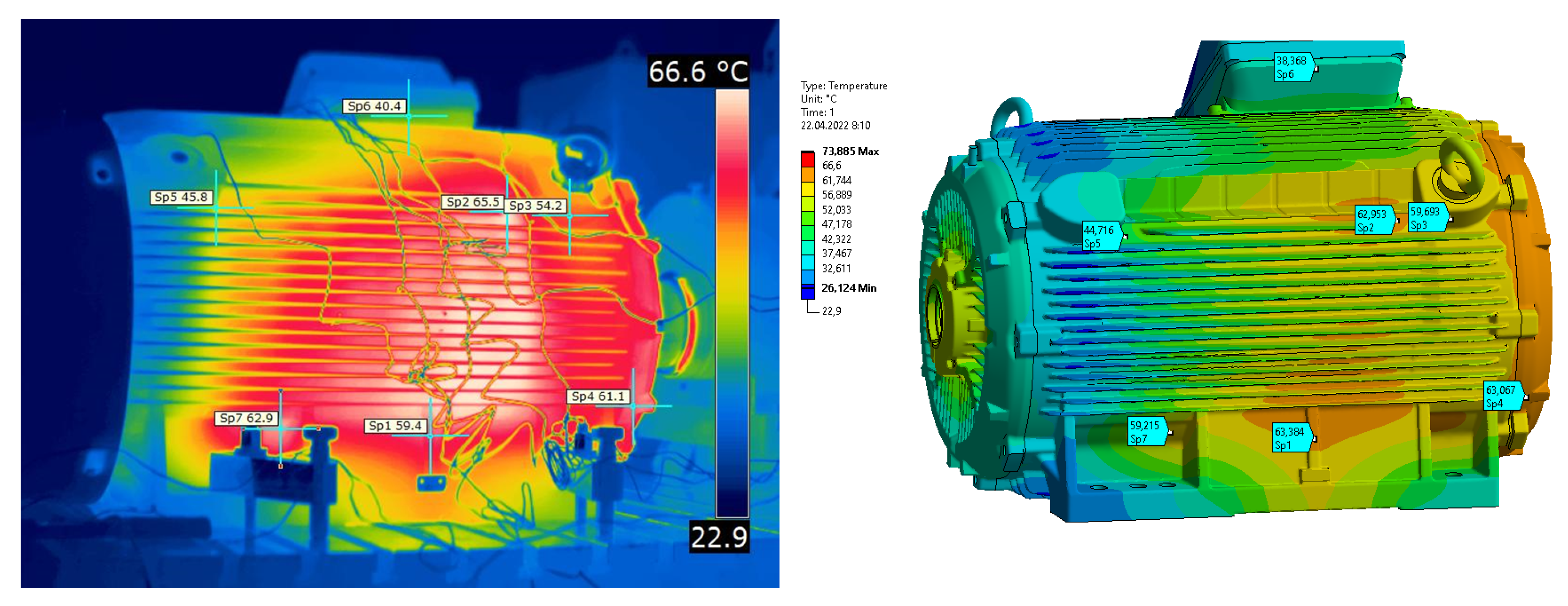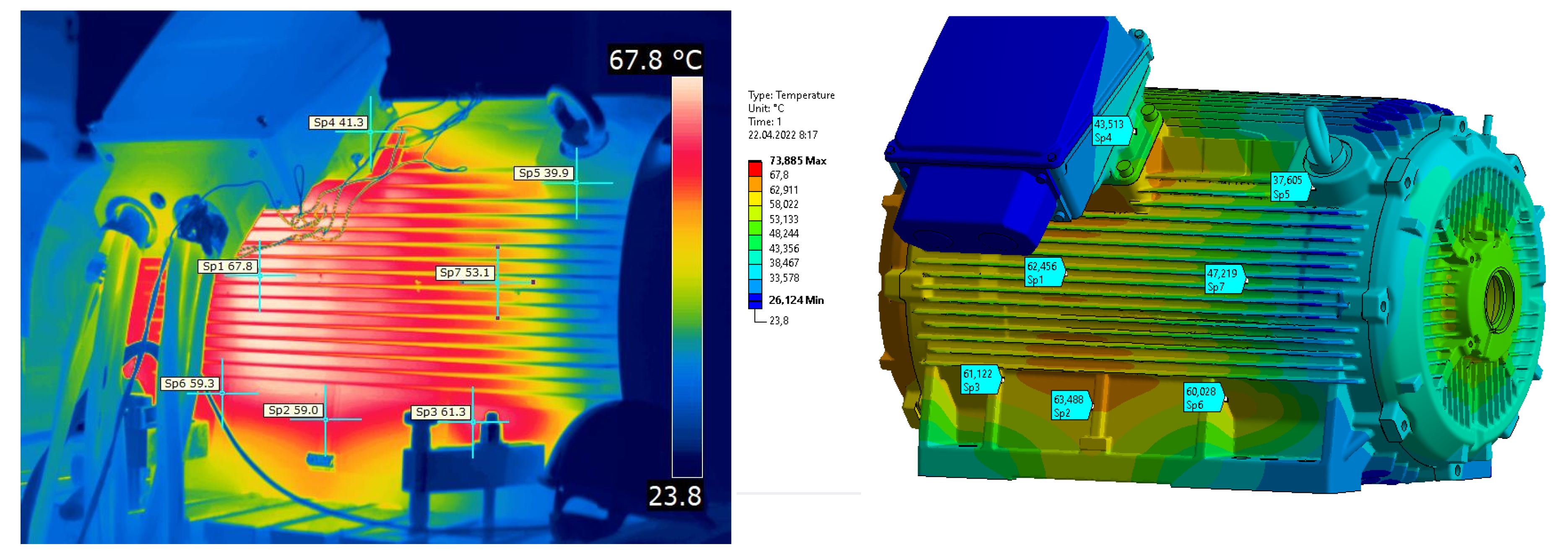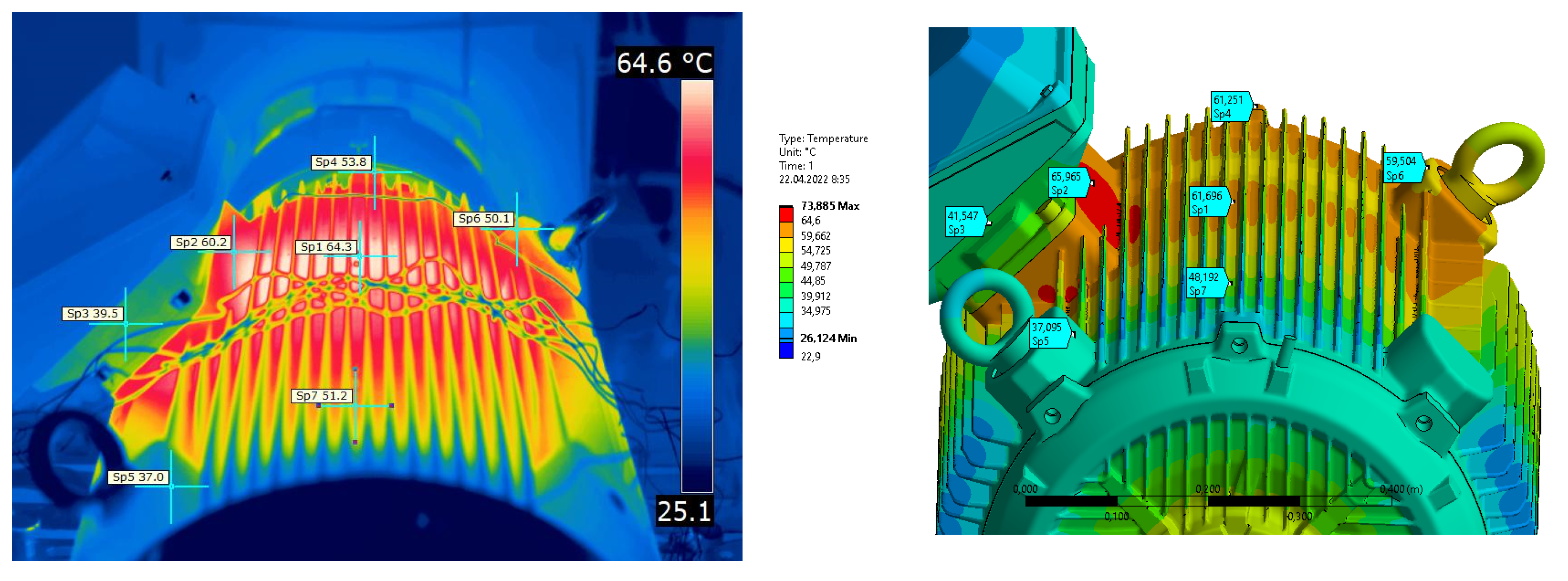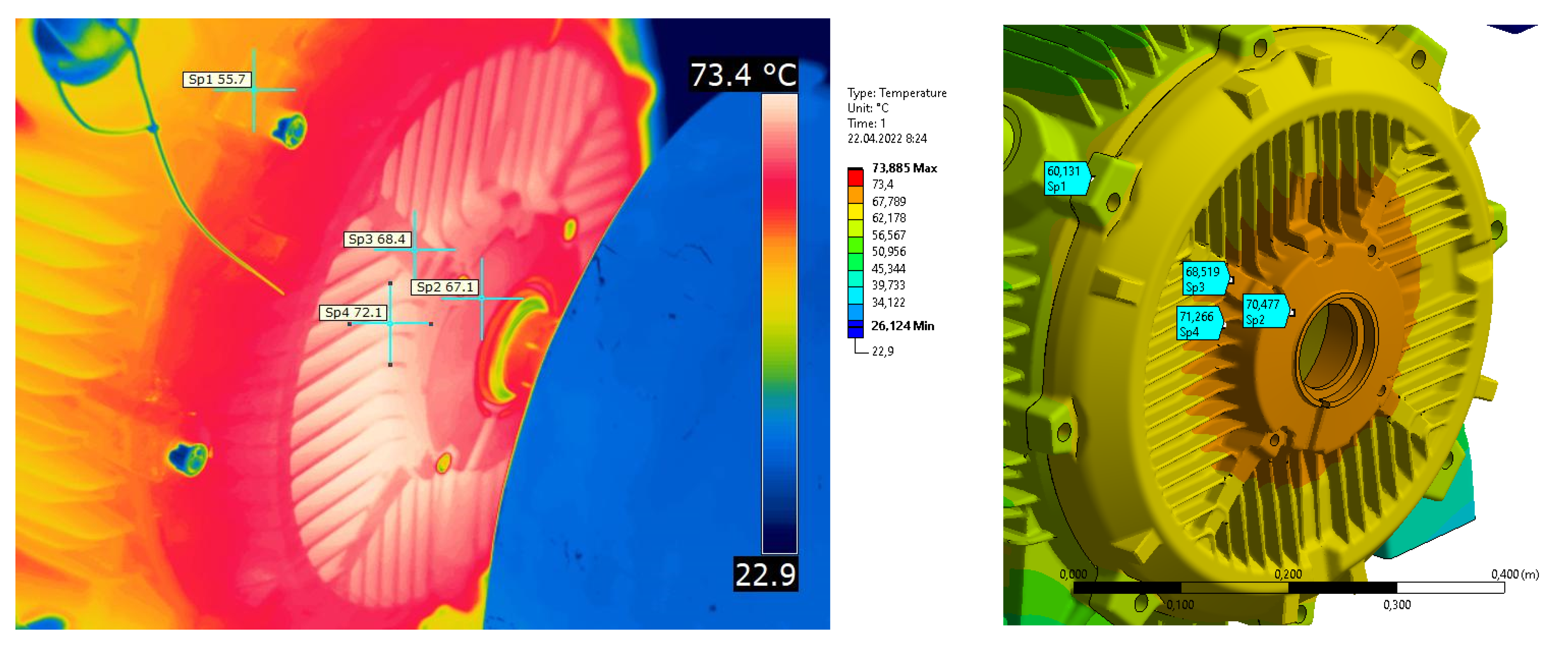1. Introduction
Before proceeding further, clarifying some of the terms and abbreviations used in this article is good. The new methodology was developed in ANSYS 18.2 software using the CFX and Static Thermal module. The CFX module is based on the Finite Volume Method (FVM) and simulates fluid flow. The Static Thermal module is based on the Finite Element Method (FEM) and calculates steady-state heat transfer in solids. As it is known, Computing Fluid Dynamic (CFD) simulations can also be calculated by the FEM. For this reason, when the FEM approach, FVM method, or conjugate heat transfer (CHT) is mentioned, an indirect reference is made to these two ANSYS modules. Achieving high energy efficiency values for induction motors is an intensively discussed problem. The efficiency of the induction motor is dominantly influenced by the temperature of the rotor and the stator winding. One widely used method for predicting the temperature field in electrical machines is the so-called lump thermal model. It is based on an electrical circuit consisting of resistors and capacitors that replace the materials’ thermal resistivity and heat capacity. Each component or part of the machine is described as a node, and then the solution gives the mean temperature of each node. The system of equations can contain from two to a theoretically infinite number of nodes. As the number of nodes grows, so does the accuracy of the description of the real problem. Unfortunately, this approach has the most limitations and is based on many assumptions. For example, the motor structure is closed, bearings are not considered, the shaft is not subject to thermal dissipation, the motor is symmetrical in the axial direction, etc. Furthermore, a significant disadvantage of this approach is that the user will not see the temperature gradient in the different parts of the engine. The next disadvantage is in accurately determining the average HTC on the motor surface. Until now, the HTC has been determined approximately using empirical relationships. On the other hand, its advantage is that results are obtained almost immediately. This method could be used for fast sensitivity analysis in the initial design stage of a new motor [
1,
2].
The main goal of the research presented in this paper was to develop a complex heat transfer methodology based on adequate FEM analysis, which is necessary for the optimization of cooling of the induction motors. This methodology compensates for the disadvantages of the lumped thermal model approach and the CHT approach, which is uneconomical. The requirements for the new methodology were higher fidelity but less time- and cost-consuming. Another essential requirement of Siemens was to apply this methodology to a wide range of air-cooled induction motors.
Many articles only deal with the partial problem of induction motors. As an example, there is mention of a couple of authors who dealt with the prediction of various parameters of induction motors. O. Klimenta and A. Hannukainen [
3], which deals with estimating the velocity field on small motors up to ca 60 kW. Their formula of the velocity profile was applied to our investigated big motor, and the results were different and thus could not be used. Heilles [
4] determined the HTC as a function of the longitudinal coordinate and a constant turbulence factor in the region between the fins. Many years later, authors O. Klimenta and A. Hannukainen [
3] determined the turbulent factor as a function of the longitudinal coordinate. However, even these expressions are again applicable to small motors, and the formulas failed for our investigated motor. Moreover, all of these authors express their relationships in terms of constants that are impossible to determine without measurements. Many such examples can be found in the literature. The new methodology described in this paper makes it possible to avoid these constants and, using only the CFD approach, find numerical heat transfer coefficient (HTC) values applicable as boundary conditions to an adequate FEM approach.
The paper’s introductory part focuses on determining the CHT inside and outside of the induction motor caused by the active cooling node by the CFD. Since our team can use HPC, we wanted to know how difficult and time-consuming the CHT simulation of an induction motor is and share our experience with scientists and engineers. The results from the CHT simulation served as inputs to the new or modified relationships described below. The following sections discuss the determination of heat transfer by the Finite Element Method (FEM). The adequate FEM modeling section part is divided into a few subsections. The first subsection is focused on the convective heat transfer of fluid adjacent to external walls. Appropriate relationships were found in literature, modified, and applied to all exterior walls of the induction motor. The second subsection is focused on the heat transfer in the rotor–stator air gap. The heat transfer through the air gap was compensated by artificially increasing the thermal conductivity. This approach replaces the advection–diffusion equations, which have not yet been implemented in the ANSYS FEM module. In the last subsection, the heat transfer of fluid adjacent to the internal walls is determined based on a new relationship between the shear strain rate and thermal contact conductivity. A similar relationship is developed in the concept of Reynolds analogy, which relates two dimensionless parameters: skin friction coefficient (Cf), which is dimensionless frictional stress, and Nusselt number (Nu), which indicates the magnitude of convectional heat transfer. The shear strain rate and thermal contact conductivity approach have not been found anywhere in the literature, so we consider it a completely new discovery. Finally, the results of the thermal fields and their monitoring points were compared with experimental measurements performed in Siemens laboratories. We can successfully state that we have found a methodology that corresponds positively to reality and can be used for a wide range of air-cooled induction motors. Although the differences are more significant in some places, fortunately, these places are not crucial for the reliable operation of the motors.
2. Problem Statement
A key parameter of electrical machines like induction motors is their temperature. The temperature of the rotor and stator is proportional to the losses in the winding due to the electric resistivity of the material. The machine’s effective cooling directly influences the induction motor’s total efficiency, so thermal analysis is the most important step in the design of electric machines [
5]. Despite that, the industrial engineering calculation of flow fields surrounding electrical machines has been underdeveloped compared to electromagnetic calculation.
Although the external aerodynamics considering turbulent flow between the fins of the induction motor frame has been investigated by many authors, e.g., [
3], the problem of flow induced by a fan of an induction motor is too complicated that more sophisticated approaches are needed to describe this phenomenon fully. Some empirical formulas can be used to describe the velocity profile between ribs. However, the validity of formulas is usually limited by many parameters, like the design of the frame, nominal speed, etc. So generally valid empirical formulas describing external aerodynamics for every type of electric machine do not exist.
Internal aerodynamics cannot be described by empirical formulas at all. This is due to more complexity of the flow field and the complicated shape of the internal cavities of induction motor, so there does not exist studies that deal with complex 3D internal aerodynamics of electric machines and specify the method for the empirical solution of the internal flow. The only exception to internal aerodynamics is the rotor-stator air gap. The air gap may be analysed as a concentric cylinder gap with a stationary external cylinder and a rotating internal cylinder. This flow is known as Taylor–Couette flow [
6]. The flow regime and other parameters necessary for heat transfer can be estimated based on dimensionless numbers, especially Taylor and Reynolds numbers. As mentioned above, the aerodynamics analysis of the induction motor is problematic and experimental measurement of the flow field is difficult and for internal flow almost impossible, so the CFD simulation of CHT of the induction motor has been established to analyse external and internal flow.
Model Description
In our research described in this paper, an induction motor with a nominal power of 315 kW, nominal speed of 2987 rpm, and weight of approximately 1400 kg provided by Siemens, s.r.o. Elektromotory Frenstat has been used. The 3D model of this motor is shown in
Figure 1. The CAD model contained up to 150 parts excluding electrical windings and slot liners. The complete motor structure is made of cast iron. Terminal box (D) consists of three parts connected by bolts, including a terminal plate. The stator core (K) is connected to the motor frame (C) by an overlap fit. It is made up of hundreds of steel sheets. The regular air gap pattern around the stator assembly perimeter is formed by technological processes. Forty-eight electrical winding packs (L) are embedded in the stator core, and they are separated from each other by slot liners. The rotor part consists of a rotor core (M), shaft (Q), and aluminium rotor cage (N). The rotor core is made up of hundreds of steel sheets. The two ball bearings (O) are mounted in the nondrive end-shield (G) and drive end-shield (B), and they are lubricated by bearing grease. Both bearings are sealed with a bearing cover (P) and shaft sealing ring (R). Both shields have internal and external cooling fins for better bearing heat transfer. A small fan wheel (I) is designed to reduce mechanical losses and high noise levels compared to the motor diameter. Because of bidirectional operation, it is designed with straight blades. It is covered by a fan cowl (J). The motor frame is equipped with a pair of holders (E) for easy handling. The inner region of the motor is filled by three domains: (1) main endcap air (V), (2) ball-bearing air (U), and (3) side ball-bearing air (T). The individual positions are shown in
Figure 2.
The geometry was minimally simplified or modified to achieve the most accurate results. The bolt heads (S) were capped. The washers were united with bolts. The circlips were united with the shaft (Q). The electrical winding (L) was divided into two parts. The first embedded part contained a parallel arrangement of individual wires. The second torus part contained a circular arrangement of individual wires. In both cases, individual wires were replaced by a solid domain. Slot liners consisting of PET film were neglected. The air gaps between the stator assembly (K) and the finned frame (C) were neglected. The size of the air gap between the stator assembly (K) and rotor assembly (M) so-called rotor–stator air gap was relatively large so it was included in a simulation. The fan cowl (J) was made of plastic, and the contact surface between the motor frame and the fan cowl was small; therefore, the fan cowl was neglected in the FEM simulation only.
The individual parts were precisely moulded together to achieve the correct contact interface between them. For this reason, access to the interior of the motor body was only possible through one small air hole drilled in the rear end shield. Assuming that it is neglected, it is possible to solve the internal and external air-flow velocity independently of each other and thus also significantly reduce the time-consuming task.
4. Orthotropic Material Models
Induction motors are created from different variations of material types. For small dimensions and performance motors, its frame material is mostly aluminium alloys. Cast iron is used for motors of large dimensions and power outputs. The end shields are chosen in a similar way. Fan wheels and fan cowls are made of aluminium alloys or plastics. The shaft, bearings, screws, and others are made of steel. In terms of physical properties, all that materials are isotropic, and determining the material model is not a problem. Thermal conductivity, specific heat capacity, and density are constants given in material data sheets or tables. In contrast, the stator, rotor, and windings are a kind of composite of more than two materials. To reduce the computational time requirements, engineers deal with adequate analytical relationships describing reality in the form of orthotropic material models.
One of the researchers who dealt with this issue is Benion [
32]. He dealt with the design of orthotropic material for stator and rotor lamination stack. The stator (rotor) consists of a steel sheet of certain magnetic properties stacked on top of each other with a thin layer of insulating coating between them. Motor lamination thermal conductivity is defined in the form (
26).
where
[W/mK] is the through-stack thermal conductivity,
[m
K/W] is the interlamination thermal contact resistance,
[W/mK] is the lamination thermal conductivity, and
t [m] is the thickness of the steel sheet. The developed model for lamination thermal contact resistance to enable estimates of through-stack thermal conductivity for new materials is defined in the form (
27).
where
[m] is the surface roughness of contacting surfaces,
P [Pa] is the contact pressure,
H [Pa] is the surface microhardness,
[m] is the lamination coating thickness, and
[W/mK] is the air thermal conductivity at 55 °C.
The through-stack thermal conductivity is
= 1.52 [W/mK] for our motor under investigation. The thermal conductivity in the
x and
z direction was left at
=
= 36 [W/mK]. Thermal conductivity values can also be transformed to the cylindrical coordinate system
=
,
=
and
=
. The transformation from the Cartesian coordinate system to the cylindrical coordinate system is shown in
Figure 7. The density and specific heat capacity were left unchanged because the volume ratio of the lamination coating thickness to the steel lamination stack is negligible. All lamination constants for the motor are summarized in
Table 3.
An electrical winding typically contains three materials: the conductor material, the impregnation material, and the conductor insulation material. A typical wire arrangement in the stator groove is shown in
Figure 8. Ideally, the wires are arranged according to region 2, but the reality is shown by region 1.
The analytical approximation for estimating thermal conductivity for winding according to the authors Hashin and Shtrinkman [
33,
34] was used. The expression (
28) has been proposed by a number of authors in various forms [
35,
36,
37,
38,
39], and it is successfully applied to electrical winding homogenization in [
40].
where
[W/mK] is the equivalent thermal conductivity,
[W/mK] is the equivalent thermal conductivity of the insulation amalgam, which is defined in form (
29),
is the volume ratio of conductor and it is taken to be equal to the packing factor
,
[W/mK] is the thermal conductivity of conductor.
where
[W/mK] is the thermal conductivity of impregnation insulation,
[W/mK] is the thermal conductivity of conductor insulation,
is the volume ratio of impregnation insulation,
is the volume ratio of conductor insulation. The relationships between the packing factor, total volume, impregnation volume, conductor volume, and conductor insulation volume are given by (
30)–(
34) for a round conductor in which
[m] and
[m] are the conductor radius and the insulation thickness, respectively.
It is important to mention that the approximation is formulated only for the cylindrical shape of conductors and does not apply to general conductor profiles. The two-step homogenization requires reformulation if the conductor profile is changed. Material properties of winding are shown in
Table 4.
The equivalent density (
35) and the equivalent specific heat capacity (
36) were calculated according to [
41]. The air’s density and specific heat capacity were neglected due to the complete filling of the stator slot with impregnation. Expression (
35) or (
36) can be used analytically to calculate
if we substitute them for the thermal conductivity of each material.
where
[kg/m
] is the equivalent density,
[J/kgK] is the equivalent specific heat capacity,
is the volume ratio of conductor,
is the volume ratio of impregnation insulation,
is the volume ratio of conductor insulation,
is the volume ratio of the air.
The equivalent material properties of electrical winding are shown in
Table 5.
The equivalent thermal conductivity can be transformed from a cartesian coordinate system to a cylindrical coordinate system. However, the electrical winding geometry had to be changed first.
Figure 9 shows the before and after modifications. The slot liner was removed. Instead, it was simulated by a thin wall. The stator slot was filled by electrical winding.
The orthotropic thermal conductivity setting for the stator slot is as follows: = = and = . The orthotropic thermal conductivity setting for the end-winding is as follows: = = and = .
The temperature of the induction motor was measured in a laboratory chamber with an ambient temperature of 20.2 °C. The thermal parameters for the external air domains were set as follows: air density = 1.188 [kg/m]; dynamic viscosity =
[Pa · s]; thermal conductivity = 0.0262 [W/mK]. An air temperature assumption of 60 °C was chosen for the internal air domains. The values for the internal air were set as follows: air density = 1.046 [kg/m]; dynamic viscosity = [Pa · s]; thermal conductivity = 0.0282 [W/mK].
Material properties of the individual parts are summarized in
Table 6.
5. Induction Motor Looses
The power loss in electric motors can be divided into four groups according to the characteristics of its generation [
25,
42,
43,
44].
(1) Iron losses. The main losses are divided into hysteretic losses and eddy current losses. These losses are due to the properties of the magnetic material that is used. Eddy current losses are greatly affected by the area over which the currents can close. Hysteretic losses are due to the overmagnetization of the material. Additional losses in the iron are due to magnetic field oscillations caused by the effect of air gap nonuniformity caused by slots.
(2) Electrical losses. Electrical losses are also called Joule losses. The current passing through the stator or rotor conductor generates Joule heat. Electrical losses make up the majority of the total losses in most motors.
(3) Mechanical losses. These are caused by mechanical friction and aerodynamic drag. This includes the bearings and the fan wheel.
(4) Additional losses. These losses include those produced by vibration and acoustics but are mostly due to dissipative magnetic fluxes and higher harmonic fluxes.
Measurements of the motor losses were performed in an equipped Siemens laboratory chamber. Measuring and calculation of efficiency were in accordance with IEC/EN 60034-2-1:ED.2-14. The basic test condition was: (1) The ambient temperature was 20.2 °C. (2) The load test condition was set to 100%, which corresponds to 315 kW of motor power. (3) The angular velocity was 2987 [1/min]. (4) The operating temperature of the motor was reached.
Siemens laboratory provided a summary report of the measured loss values, which were applied to the conjugate heat transfer (CHT) model with respect to the solid domains.
The total value of the iron losses was 3972 W. It was divided between the rotor and the stator domain in the 1185 W to 2786 W ratio (see
Figure 10).
The corrected stator winding losses was 2311 W. The loss distribution for the embedded wires inside the stator was 1293 W and 509 W for each end-winding (see
Figure 11).
The corrected rotor winding loss was 1365 W. The loss distribution for the cage wires inside the rotor was 1293 W and 763 W for each short circuit rings (see
Figure 12).
Mechanical losses are more difficult to define. According to the report, the sum of all these losses was 1870 W. These had to be divided among the external loss (fan wheel), internal loss (rotor), and frictional loss (ball bearing). Only the frictional loss must be determined for CFD and FEM simulation. Two approaches in [
7] give the procedure for evaluating mechanical losses. Frictional losses of 360 W were estimated for both ball bearings.
6. Conjungate Heat Transfer Model of Induction Motor
Using the HPC infrastructure available at IT4Innovations, CFD simulations can be performed for the complete induction motor without significant shape simplifications. According to the presented approach, a virtual numerical model can partially replace experimental measurements. It allows for accelerating the process of fan section design and can estimate the impact of each modification on the parameters of the induction motor without the production of the physical prototype.
The final numerical conjugate heat transfer model (CHT)-contained a total of 49
fluid and
solid domains that were connected by 109 defined interfaces. The total number of elements was approxiamtely 240 million. The external
fluid domain contained 130 million elements, the internal
fluid domain contained 73 million elements, and the
solid domain contained 35 million elements. The boundary layer contained 10–15 elements at a 2–2.5 mm thickness for all fluid domains except the air gap between the rotor and stator. There were 25 elements, and a mapped mesh was created.
Figure 13 shows a cross-section through the fins and air gap of the computational mesh.
The external
fluid model contained one stationary and two rotating domains. The stationary domain consisted of multiple regions that were interconnected by a conformal mesh. The elements became smaller toward the motor body with each adjacent region. The dimensions of the stationary domain were modelled at a sufficient distance from the motor frame. The first rotating domain was created around the drive shaft extension and the second one around the fan wheel (see
Figure 14). The open pressure boundary condition
Opening Press. and Dirn = 0 [Pa] was applied at all outer walls of the stationary
fluid domain except the bottom side. A
No Slip Wall condition was applied. The
Flow Direction was set to
Normal to Boundary Condition.
The internal
fluid model contained five stationary domains and three rotating domains (see
Figure 15). Air gap domain was static, but the rotating wall condition was set to the side of the rotor surface. The grease inside the ball bearings was neglected.
The
solid domains (stator, rotor, windings) were created primarily of hex element types. The stationary
solid domains consisted of multiple regions that were interconnected by a conformal mesh (see
Figure 16). The interface
General Connection between
fluid and
solid domains was set.
Reynolds number outside and inside the motor is generally greater than 2300, so the turbulence model is also required to describe the fluid flow. According to the CFD theory [
2,
45], the two-equation eddy-viscosity turbulence model SST k-
was chosen. The assumption of incompressible flow was considered. A CHT model using the already prepared external and internal
fluid domains was set up. More relevant information was published in [
7], including a grid convergence study.
The orthotropic material properties were applied according to
Table 3 and
Table 5 for windings, stator stack, and rotor stack. The remaining material properties were applied to the other parts of the induction motor according to
Table 6. An assumption of an incompressible flow with constant air values at 20 °C was set for the external
fluid domain and 60 °C for the internal
fluid domain. According to [
46], a thermal resistance of 200 [mm
K/W] was defined at the interface between the stator and the motor frame. The thermal resistance of 1000 [mm
K/W] between the motor frame and the floor was defined. The other thermal resistance was not applied. The
thin wall with a thickness of 0.36 mm between the stator and the winding was defined.
Total Source was chosen for losses according to
Section 5.
It was impossible to run the transient analysis because the operating temperature of the induction motor was reached after approximately 4 h. So, steady-state analysis was chosen instead. The following preprocessing and solver settings were chosen; see
Table 7 and
Table 8. The analysis was launched on 432 cores. The total computational time was 400 h (approximately 16 days). This computational time included a job startup, mesh refinement in critical domains, change of mesh interfaces
, and steady-state time. The memory requirement for the job was about 1900 GB RAM.
The most critical measuring points have been defined, as shown in
Figure 17. The figure is for illustrative purposes only and can be used for all motor types. The description of the measuring points and their thermal values are given in
Table 9.
The first pair of results (T1 and T2) shows the temperature inside the end-windings. It can be seen that the end-winding closer to the fan wheel is less thermally stressed than its more distant counterpart. Compared to the experimentally measured data, the difference is approximately 15 °C and approximately 30 °C higher. The inaccuracy in the simulation is due to several reasons: (1) Simplifying assumption of replacing the individual wire bundles with a single domain defined by the orthotropic material model; (2) incorrect input data for determining material constants for the orthotropic material model. In reality, the 3D model of the end-winding provided by Siemens does not correspond correctly to the volume fraction of a conductor and impregnation. The volume fraction in the end-windings was the same as that used in the wires located in the stator grooves; (3) the uniform end-winding geometry does not allow air to pass through the individual wire bundles and thus prevents cooling in its center; (4) the rotation direction of the coiled helix, which forms an imaginary anuloid, also plays a small role.
An important result is the ball-bearing temperature (T3). This bearing shows approximately 30 °C higher temperature than the bearing on the other side (T4). Ball-bearing life decreases significantly with a higher temperature; thus, its replacement becomes more frequent. It should be remembered that a higher temperature gradient also causes negative stress on other parts. Individual parts deform unevenly, which can affect higher noise level due to excited vibrations.
The temperature at the other measuring points corresponds to reality and needs no further comment.
Figure 18 shows the temperature distribution on the motor surface. The temperature range is from 20.2 °C to 85 °C. It can be seen that the coldest place is the fan blades, which demonstrate the highest HTC values. On the other hand, the hottest place is the area near the ball bearing embedded in the drive end-shield.
Figure 19 shows temperature distribution on the internal parts of the motor. The temperature range is from 20.2 °C to 132 °C. The hottest parts are the end windings, and the coldest one is the end of a shaft on the fan side.
The temperature results at the monitoring points are not sufficient to reliably verify the numerical model. Therefore, the temperature on its surface was also monitored. Thermal camera Flir P620 was used to measure the surface temperature of the investigated motor. It is a high-performance infrared camera that delivers accurate temperature measurements. The P620 includes a high-definition 640 × 480 infrared detector that delivers exceptional resolution and image quality for accurate infrared surveys. As a result, accurate readings can be taken on smaller objects at safe distances. Its detailed specifications are shown in
Table 10.
Figure 20 shows the first pair of temperature results on the left side of the induction motor. It can be seen that the CHT model shows a cooler region in the roughly central part of the motor. The temperature zone does not correspond, and the temperature difference is about 10 °C. The monitoring point of the thermal camera shows a temperature of 59.8 °C, whereas the CHT model shows 53 °C. The real temperature peak between fins is 67.4 °C and 55 °C for the CHT model.
Due to the high complexity of CHT model preparation, these significant temperature differences were investigated by a simpler internal CHT model. The basic CHT model did not include a
fluid domains which should be located between the motor frame and the stator. The four
fluid domains were intentionally removed because of their shape complexity with respect to future high elements count.
Figure 10 shows the rows of air pockets that were created by the technological workflow during the cutting of the stator plates. The air cavity thickness is 2 mm and contains many sharp edges.
The investigation revealed that the main cause of cold areas in the middle part of the motor is the absence of circulation flow inside the induction motor. Cooler air flows from the non-drive end shield to the drive end shield between the shaft and the rotor stack. The average axial air velocity is approx. 7.5 m/s. The hot air flows back between the motor frame and the stator stack. The average axial air velocity is approx. 1.5 m/s, and its inlet temperature is in intervals 70–80 °C.
Figure 21 shows the direction of the airflow by black arrows. Significant difference (approx. 10 °C) is also evident in
Figure 22 and
Figure 23.
Another significant difference in the results is evident for the holders (E) and the terminal box (D). The holders and terminal box show much higher temperatures than reality (approx. 20 °C). This is due to the neglecting thermal contact resistance between the motor frame and terminal box (holders).
Figure 24 shows temperature distribution on the drive end-shield of the induction motor. The maximum temperature measured at the front of the shield was 73.1 °C. The CHT model showed a temperature of approximately 10 °C higher. This large inaccuracy is due to the lack of air circulation inside the motor. It is also caused by a missing clutch coupling, which partially dissipates heat from the shaft. A heat bridge is visible at the interface between the drive end shield and the motor frame.
The purpose of creating the numerical model was to determine the overall complexity of the simulation. By comparing the results between the numerical model and the measured data, the following conclusions were summarized: (1) The present study shows that it takes weeks of pure time just to prepare a simulation for a run. (2) The simulation is hardware-demanding, and it was necessary to use high-performance computing (432CPU, 1900GB RAM) to run it. (3) Each new problem discovered in the numerical model disproportionately increases time consumption. For example, the CFX preprocessing response requires a few seconds (t > 5) for each “click” mouse button. Rotating or zooming of the model is then done within minutes. (4) A numerical grid containing millions of elements is more susceptible to creating elements with negative volume; therefore, more frequent meshing is necessary.
For the reasons mentioned above, the numerical model was further tuned using only the FEM approach. The FEM approach meets the primary requirements of the project, which is to be time- and cost-efficient. All the limitations of the CHT model have been eliminated or compensated by using a new approach applied to the adequate FEM model.
9. Conclusions and Discussion
The following conclusions were summarized from all the results.
The results are more than satisfactory since an adequate FEM model replaces the complex nonstationary conjugate heat transfer flow analysis. Two new methodologies for determining the heat transfer coefficient have been discovered to replace the highly demanding CFD model, for which a supercomputer is needed to make it computable in a reasonable time.
The first methodology specifies the relationship for calculating the heat transfer coefficient discovered by Mr. Heiles, for which a turbulence factor had to be determined. The turbulence factor cannot be determined by anything other than measurement, which is inappropriate and economically unacceptable for Siemens. The new methodology determines the value of the turbulence factor based on the turbulent kinetic energy obtained from the calculation of the external flow. This procedure assumes that the turbulence profile, along the length of the motor frame, is the same for both quantities. The turbulence factor was determined from the average value of the turbulent kinetic energy and its algebraic modification. The maximum magnitude of the turbulence factor was determined from the motor surface temperature results. Unfortunately, its numerical determination is not easy, and it is necessary to have at least the measured temperature on the surface of the motor frame, according to which we fit the calculated turbulent factor of the FEM model. With increasing data, from the received FEM calculations, the statistical method will already make it possible to accurately determine its magnitude without experimental data.
Due to the high turbulent flow inside the motor, heat is transferred evenly to hard-to-reach areas. The high thermal conductivity of the air domain compensated for this dynamic behavior. However, in order to avoid excessive heat dissipation from hot surfaces, the heat flow had to be “throttled” in some way. The second methodology defines this throttling. This approaches the “throttling” by using the new quantities intensity of shear strain rate (ISSR) and thermal contact conductivity (TCC). A sensitivity analysis was performed between and . It was found that the [W/mK] correlates to the [1/s m]. Thus, at the contact interfaces between the air domains and other parts inside the motor, contacts were defined with a calculated TCC that does not allow unrealistic amounts of heat to be transferred to the ambient air.
The accuracy of the heat flux setting in the air gap between the rotor and the stator is important. In this case, the heat flux calculated by CFD is compared with the heat flux calculated by the FEM model. The two values must be equal or very close. The relatively simple geometrical shape of the air gap allowed us to calculate the effective turbulent conductivity. Effective turbulent conductivity is the artificially increased molecular conductivity of the fluid, which carries the information of increased heat transfer due to turbulent flow. The effective turbulent conductivity calculated from a CFD model may differ from that of an adequate FEM model, but the equality of heat fluxes must be preserved for both approaches.
The contribution of the new calculation methodology brings huge time savings for optimising old designs and prototype development while keeping the accuracy of the results. The complex analysis using the CFD approach greatly demands computer hardware. For the calculation of this particular engine, 2200 GB of RAM, 432 CPUs, and 4 days were required, not to mention the time-consuming aspects of the overall model preparation, such as geometry preparation, boundary layer meshing, and task setup, including dozens of contact interfaces. On the other hand, an adequate FEM model offers high savings for everything. Only a workstation with a maximum of 256 GB RAM, 8 CPUs, and a maximum of 2 h of computation was needed. There was no need for a complex computational grid, which often crashed at the boundary layers. The flow simulations were solved separately on the external and internal domains without heat transfer.
In the future, Siemens will collect data to create its database from which it can statistically determine or estimate turbulence factors, flow velocity, and more. Then, an adequate FEM model is almost set up right away for the final simulation, and optimization of the old design takes days of work at most.
